Saturday, August 13th, 2011
Fluxus Survival Fundamental
George Maciunas Seeking Shelter

Alison Knowles provides this drawing (2011) of George Maciunas. The background image
traces part of The Berlin Wall, in yellow, the satelite image is provided by NASA.
August 13th, 2011
by Alison Knowles
Before we arrived in Germany that first winter, to live in the Ehlhalten house that George had built with the potato farmer, we learned that George had worked the previous winter living as a draftsman, by day, and in the back of his car, by night. This was verboten, of course, and took daily ingenuity, courage and presence of mind to carry it off. Each night became a performance. First George bought the food at the PX, either eating there or adding to his stash of small stock items for the car. No need to eat in a restaurant – ever!
One imagines the interior of the car as the ultimate in space organization, full of boxes, the glove compartment becoming a desk, the piles of clothing that had to be worn each night in neat piles in the back seat on the floor. The driver’s seat provided storage for food. George would exit right along with the others from the main entrance to the parking lot, then detour and double around back to enter the service entrance before the gate closed for the night. Once secured in a far corner of the lot, the arduous task of dressing against the brutal cold must begin. With coats, sweaters and hats the disguise was complete.
Thus buffered, he could sink into the back of the car until dawn. Rising demanded precision and attention to detail. He could exit from the car to the basement of the building where the maintenance people shower and shave. Then, back to the car to dress (in the front seat) grab a bite from the food stash, probably bread and milk. He was then ready to exit unobserved when the first deliveries came in. Once out the gate, he retraced to the front entrance and drove in with the others to be at his desk by eight.
This was truly a Fluxus vehicle: one ready for a quick getaway, with all the stuff in one place. Everything in it was of the utmost daily necessity and miniaturized. The gate keepers, no doubt, observed what George was doing and enjoyed the game as much as he did. The question is, did George suspect that they knew? What was verboten, of course, was to end the game by speaking to the “authorities.”
George Maciunas: was a Lithuanian-born Manhattan based artist operating in Europe and the USA between the 1950’s and 1970’s. He was the defining founder of Fluxus, a small group of experimental artists who grew into a large international community of artists, architects, composers, and designers. Other leading members who forged this movement included Dick Higgins, Emmett Williams, Alison Knowles, George Brecht, John Cage, Joseph Beuys, Nam June Paik, Charlotte Moorman and Yoko Ono. Maciunas is most famous for organising and performing early Fluxus Concerts and for assembling a series of highly influential artists’ multiples and selling them through his own Fluxus store on Canal Street in NYC. He is also credited with having pioneered SOHO as an artist’s enclave in lower Manhattan.
Alison Knowles: American visual artist known for her soundworks, installation, performances and publications, and as a founding member of Fluxus. In 1967, Knowles produced what is considered to be the first computerized poem The House of Dust in collaboration with composer James Tenney. In the 1960s, Knowles composed the Notations book of experimental composition with John Cage, and Coeurs Volants, a print with Marcel Duchamp. Her acclaimed exhibits and performances include two walk-in book installations “The Big Book” and “The Book of Bean.” In 2008, she performed three Event Scores at the Tate Modern in London, and in 2009 she exhibited and performed in “The 3rd Mind” American Artists Contemplate Asia, 1860-1989 at the Guggenheim Museum. She was appointed guest professor at Documenta X in Kassel, Germany, and in 2009 was an artist-in-residence at the Radcliffe Institute for Advanced Study at Harvard University. An edition of The House Of Dust is due to publish this Fall. She recently performed at the White House.
Ehlhalten is approximately 12 km north east of the state capital Wiesbaden, Germany, at the edge of the Taunus mountains. As a boro of Eppstein it is joined by Bremthal, Ehlhalten, Eppstein, Niederjosbach and Vockenhausen. Ehlhalten is the boro with the fewest number of inhabitants (about 1350) but the largest area due to its rather big forests. According to legend, Ehlhalten once provided a cutter that tailors used at the water of the brook in Ehlhalten. As the water rose and fell, affecting the measurement of the inch, people cried: “Elle halten!” (“hold the inch!”), leading to the name Ehlhalten.
The Berlin Wall was a barrier constructed by the German Democratic Republic (GDR, East Germany) starting on 13 August 1961, that completely cut off West Berlin from surrounding East Germany and from East Berlin. The barrier included guard towers placed along large concrete walls, which circumscribed a wide area (later known as the “death strip”) that contained anti-vehicle trenches and other defenses.
#permalink posted by Artist Organized Art: 8/13/11 01:58:33 PMTuesday, July 5th, 2011
VENICE RADIATES:
La Biennale di Venezia 2011

Josh Smith (below), Maurizio Cattelan (pigeons in signage above) and Latifa Echakhch (front)
‘If you want to do something new, you have to look at the past.’
- Mauro Zennaro, typeface and visual identity designer, Rome June 2011
by Erika Knerr
The 2011 Venice Biennale orchestrated by Bice Curiger is titled ILLUMInations. The selection of Ms Curiger jettisons an exhibition and catalogue that is both “evocative and stringent,” to use her descriptive words. ILLUMInations is evocative of a wide range of allusions spanning centuries. She does this by including Tintoretto as an artist in her exhibition, building the show thematically around three of his major late works. The Stealing of the Dead Body of St Mark 1562-66, and the Creation of the Animals, 1550-53 are temporarily on loan from their long time home in the Gallerie dell’Accademia, and the Last Supper, 1592-94, from the San Giorgio Maggiore Basilica.
The president of the Venice Biennale Foundation, Poalo Baratta’s curious praise of Curiger is that her “strict capacity for selection and her great faith in that mysterious goddess quality evokes an expansive eagles eye view on the global scene at the moment.” In the emphasis on looking back, in order to make a leap forward, there is a sense of taking back the wild horses reins. There is a nod to the decades of anti art’s distractions and rejections, while she rolls out a crisp dawn to a wider view of our future, one giddy with a thoughtful, grounded, profound “taking the bull by the horns” bravura. OR perhaps it is a provocation to a collective spirit. We feel a call to our ancestors to whisper their secrets to us in the wind, and the concurrence of the momentous historical shifts moving throughout the Middle East and Asia today.

Tintorettto, Creation of the Animals, 1550-53
So how did the artists in Illuminations feel about showing with Tintorettto? I love that Bice Curiger took seven paragraphs of her catalogue essay to discuss Tintorretto. She questions border zones on a number of levels, finding ways to brilliantly perch the show at the intersection between the early historical masters and modernity. She erases taboos that have culturally fragmented us allowing us to move seamlessly between and across the borders of time, modalities, belief systems and national identities, while emphatically defending the values of the Enlightenment.

Sigmar Polke (left) and Seth Price (right)
Therefore by looking at fragmented identities one is able to witness the possibility of a more far-reaching cultural wholeness as a global collective. In looking back she also incorporated and recycled works previously shown in past national pavilions of prior biennales into Illuminations. Maurizio Cattelan’s stuffed pigeons were regestured, as well as the choice to include Sigmar Polke’s work shown also in the 1986 German Pavilion.
Bruno Jakob is an artist to look more closely at, who shared the opening room with Tintoretto. One of his “Invisible Paintings,” that he paints with water, steam or pure telepathy is showing in the same room guarded by Italian security that are protecting the three Tintoretto’s that grace the walls of the Giardini.
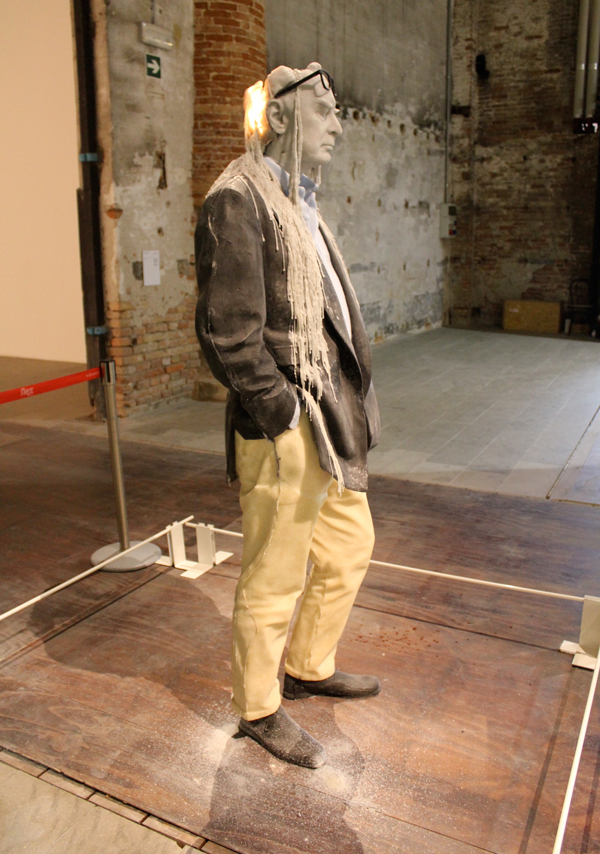
Urs Fischer
A showstopper and one of my favorite works from Illuminations is Urs Fischer’s monumental candles installed in the Arsenale. The candles gradually burn down throughout the run of the exhibition echoing his previous sculpture of three women as life-size candles from 2004. He recreated by digital cast the well-known “Rape of the Sabine Women” (1582) by Giambologna. It’s interesting that he chose the abduction of the women of Sabina as subject as they are said to be the “Mother of Rome.” The story goes that seven centuries before Christ, Romulus founded Rome and invited all the male criminals, rogues and rascals to live in Rome. They needed women, so they kidnapped many women from Sabina, hence the creation myth of the Roman Empire. There is a repurposing of the classics here that successfully form a contemporary voice to communicate with.
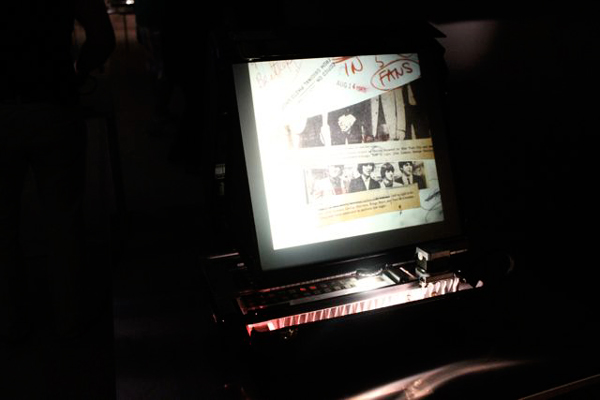
Elisabetta Benassi
Radiance is what is important in this years sprawl around the city of Venice. Bice Curiger comes to Venice like a cultural warrior, comparing the importance of self-reflection in contemporary art to the “amen” in church. ”Illuminations focuses on the core business of art”1 On this page are some examples of how the artists interpreted this theme.

Annette Kelm

Andro Wekua
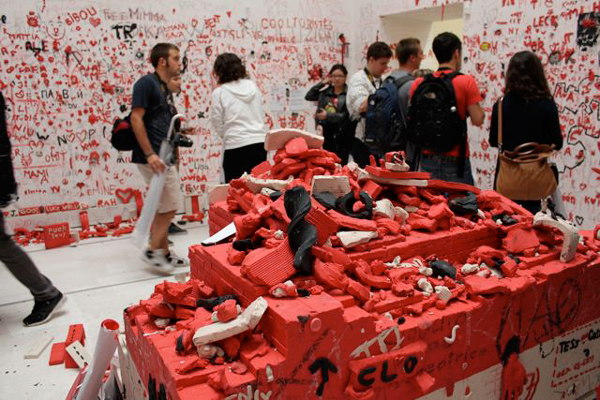
Norma Jean
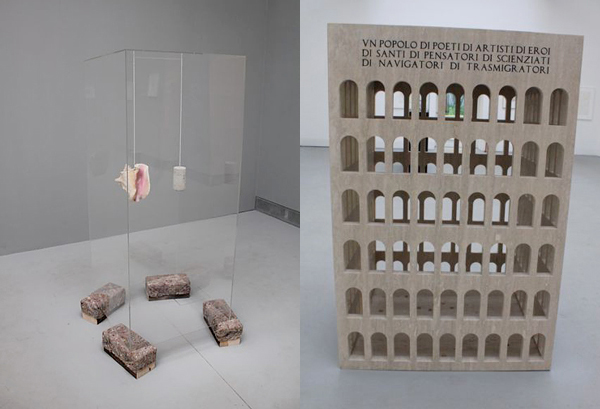
Karl Holmqvist and Gabriel Kuri

Guy de Cointet

Giulia Piscitelli
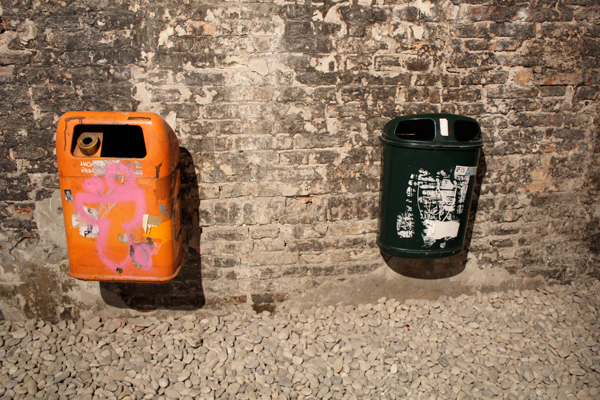
Klara Liden
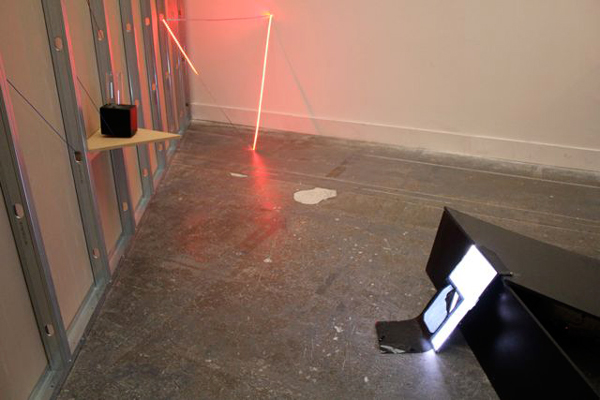
Haroon Mirza
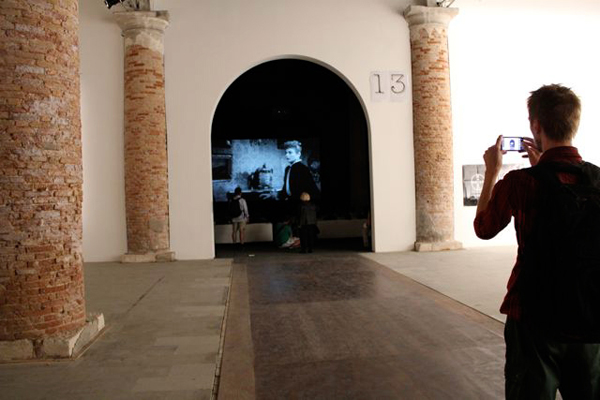
Christian Marclay
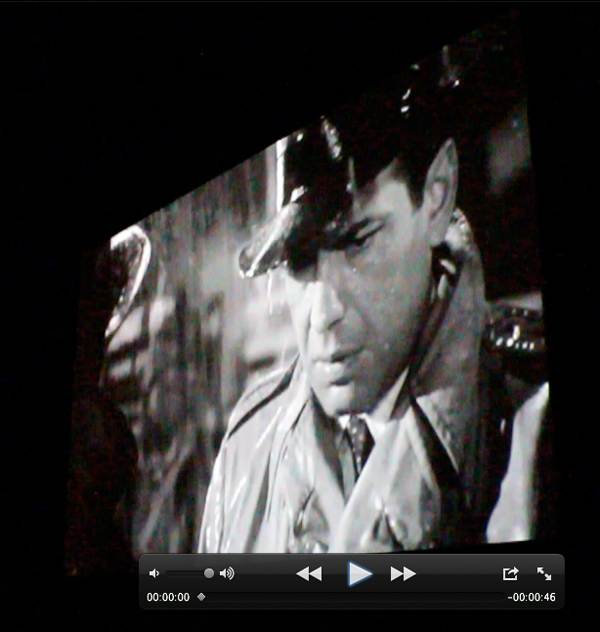

Monica Bonvicini


Bice Curiger, Director of 54th International Art Exhibition – la Biennale di Venezia. Photo: Francesco Galli.
Courtesy: la Biennale di Venezia. All other photos : Erika Knerr.
A graduate of the University of Zurich, Bice Curiger is an art historian, critic and curator of exhibitions at an international level. Since 1993, she has been curator at the Zurich Kunsthaus, one of the most important museums in the world for modern and contemporary art. Bice Curiger is co-founder and editor-in-chief of “Parkett”, one of the most authoritative and innovative contemporary art magazines in the world, published in Zurich and New York since 1984. Since 2004, she has been publishing director of the “Tate etc” magazine produced by London’s Tate Gallery. She is also the author of various publications and catalogues of contemporary art.
Erika Knerr was a 2011 participant in the SVA Master Design Workshop: Design History, Theory and Practice in Rome and Venice. She is a conceptual artist working between graphic design, painting, writing, performance, and poetry. She is publisher of New Observations magazine, a seminal art publication in New York that is currently being developed in a third incarnation with Artist Organized Art where she is Project Director/Managing Editor of Artist Organized Art’s New Media Innovations Project. Erika Knerr is a graduate of Tyler School of Art (BFA) and the School of Visual Arts (MFA). Her work has been shown internationally in Italy, Poland, Spain, Israel, Wales and the US.
#permalink posted by Erika Knerr: 7/05/11 10:31:10 PMThursday, May 12th, 2011
THE WHITE HOUSE POETRY WORKSHOP
Mrs. Michelle Obama for the President’s
Committee On The Arts And The Humanities
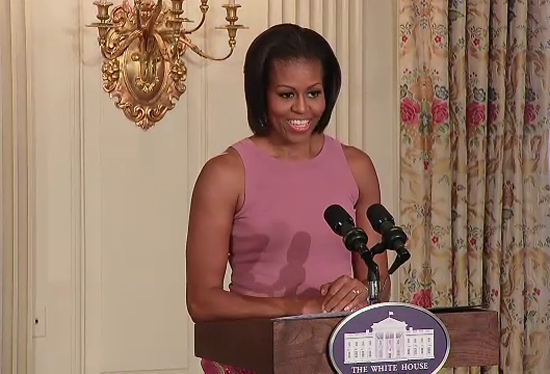
First Lady Michelle Obama speaks about the importance of poetry and self-expression
as she hosts a White House Poetry Workshop with students and poets like
Rita Dove, Billy Collins, Kenny Goldsmith, Alison Knowles, and Aimee Mann
by artist/correspodent: Jessica Higgins
Once inside the White House, I sat in a small room shaped like a kidney, many heavy guys with lots of equipment sitting at a small table. There was talk of tending their lawns. I was in there for a couple of hours, many of them brought lunch. Since I didn’t know the routine I ended up at a vending machine. They turned out to be nice fellows, one guy from Fox News offered me his soup. I ended up sort of interviewing him about the Press Industry. He gave an overview of his life style, kids in high school living outside of DC coming in when he gets a call from Fox News. A nice down to earth guy with what seemed to be a conventional lifestyle. We were considered a Press Pool and when called we stepped out into the heat. All the Press guys carried heavy equipment, I tagged along with mine, having also met a woman from a non-profit organization covering education, observing our preference for palm sized cameras we exchanged cards.
I represented myself as Myself, an Artist covering a White House event for Artist Organized Art, me being a specialist in trying to do the best I could in that mysterious way I simply trust. No pretending I was one of them, a hard nosed reporter, yet I distinctly pressed many questions inside the ‘Kidney Room.’

The Press Pool waits outside at the White House. Artist Organized Art sends
Jessica Higgins to cover the White House Poetry Work Shop
Originally someone else was chosen for this assignment, because Alison Knowles, was invited to participate in The Poetry Workshop and Evening Performances. Then, I got a sudden alert that Artist Organized Art would send me in as Press to cover the workshop. Great! But I had 45 minutes to pack and catch a train. Not fair! If, you’re covering First Lady Michelle Obama’s Poetry Workshop At the White House, in the State Room. I also needed to supply what are known as “vitals” (Social Security Number, Name, Address, Date Of Birth and so forth) to the White House for security clearance. There was a moment of pressure as the decision to participate was turning on a dime, while I “packed” without knowing if I would clear security upon arriving in Washington D.C. and presenting myself at the White House. Standing outside with The Press waiting to be admitted was beyond exhilaration, to put it mildly. After some jostling, I was waived in by the invisible hand of power and found myself inside the White House in the role of journalist.

The Press Pool waits outside at the White House. Artist Organized Art sends
Jessica Higgins to cover the White House Poetry Work Shop
Though the audience was aware there were cameras behind the rope, we ourselves were as equipment, with a sense of separation from the seated, comfortable participants.
As the poetry workshop unfolded into something really special Alison Knowles looked at the audience pointing over their heads and wiping her eyes, saying . . .’ and my daughter made it in.’ I wondered if, for one day at the White House, the poets were calling the shots. As I was scribbling away and trying to take pictures time stood still and it felt like every audience member turned and acknowledged us in the Press Pool. I nodded quietly smiling. Yet, there was meaning in pointing out another Artist organizing in the Press Pool and the daughter of one of the Artists on the panel. Anywhere in the world, even at the White House, if an Artist is exhibiting, or performing, presenting something, it’s always more meaningful if other Artists are in the audience. I realized my presence as an Artist and as someone personally connected to one of the exhibiting artists validated the event in a unique way.
Eight hours or more on Amtrak (artist in coach on value ticket) then slow waiting at the gates of the White House – the crowds were both impressive and in need of guidance from those magical workers who let you know where to go next, otherwise too chaotic. The identical ride back on the train went faster because I wrote steadily.
Organizing artists voices, giving diverse artists the chance to expose their percent of mind share while meeting other creative and alternative beings in the context of such a project, makes for an important social and public resource. It allows for artists themselves to work as organizers of a venue for cultural education. The mission of Artist Organized Art, to support artist organized media, events and cultural education, was my poetic license in the context of a very sequential choreography by the White House. I asked Joshua Selman of Artist Organized Art to say something about this for the article:
“Poetry gives us a break in the expected order of things. The inclusion of artist organizers as witnesses to cultural education at the White House makes for an especially poetic moment with the inclusion of an intermedia between journalism, art-making and organizing. It harmonizes with the results Intermedia artists enjoy entering expected art categories with unexpected results. That Mrs. Obama has arranged such a chord is astonishing and hugely encouraging to young people.” (Joshua Selman)
Opening remarks were by Elizabeth Alexander, Melody Barnes, Tiesha Hines and Mrs. Obama. The invited poets included: Elizabeth Alexander, Billy Collins, Rita Dove, Kenneth Goldsmith, Alison Knowles and Amiee Mann.
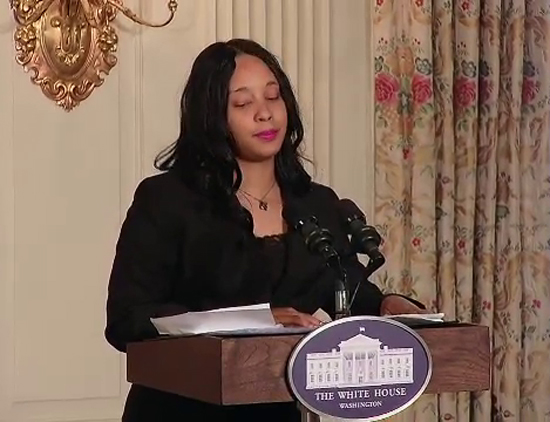
Tiesha Hines, President of the Ballou Senior High School Poetry Club, is a young Poet
and Artist Organizer known for her positive attitude and support of other Poets
Melody Barnes and Tiesha Hines stated the statistics and annecdotes showing improved grades and innovation abilities among students exposed to The Arts. Ms. Hines praised the First Lady for her extraordinary work in recognizing and supporting The Arts as critical to Education. Mrs. Obama followed, in stately presence, wearing a sequined floral skirt and looking strong and beautiful. Her message quickly matched her appearance providing profound recognition of, and empowerment to, the next generation of young students. Mrs. Obama defined her role in the issue and stated that she wanted all the invited young students from The Ballou Senior High School, present at the workshop, and the invited Artists to make themselves at home at the White House. To get comfortable. This benefited the overall workshop as the audience settled into deep attention and inquiry. The State Room was filled with teens and established poets ready to share their experience, technique and knowledge with budding poets.
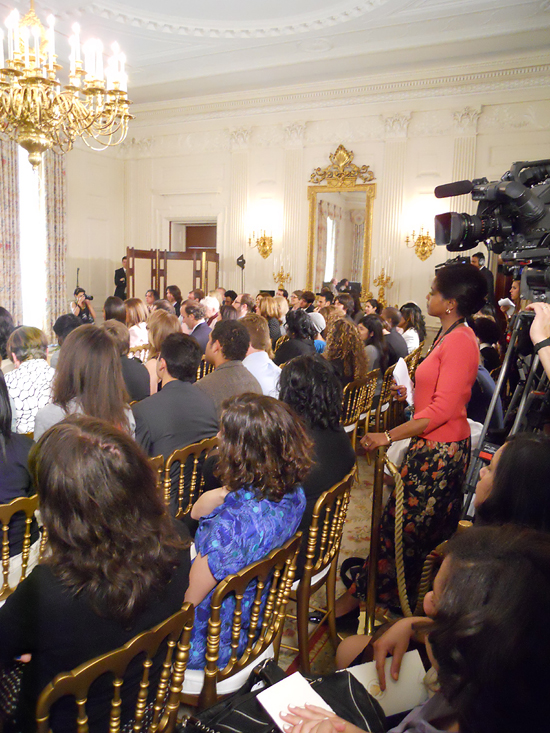
An eager crowd of invited young people follow the Poetry Workshop at the White House,
a project of the President’s Committee On The Arts And The Humanities:
Reinvesting in Arts Education, Michelle Obama, Honorary Chair
“So we’re going to do this big, fancy poetry reading this evening, and that’s all fun, and we’re going to hear some stuff. It’s going to be good. But this is the real reason, this workshop today, this is why we do it, because we’ve flown you guys here from all over the country because we want you to be a part of this conversation, sitting here in the State Room of the White House of the United States of America, because you’re just that important, right? You’re just that important. And this is the best part of the day, every time we do these. It’s today. So thank you for being here.” (Mrs. Obama)
With a huge portrait of Abraham Lincoln hanging on the wall behind the podium, Mrs. Obama spoke of many key elements to the importance of The Arts in Education. How important it is to simply recognize the role The Arts play in education for young people. She touched on how art-making helps in finding new solutions, developing gifts and establishing communities. She mentioned how she had loved creative writing in school. Making pictures with words, how it allowed her to express things that she was going through that went beyond the words she was writing.
“And even if you don’t grow up to be a professional poet, I promise that what you learn through reading and writing poetry will stay with you throughout your life. It will spark your imagination and broaden your horizons and even help your performance in the classroom… That’s why it is so critically important that we integrate the arts into schools. It is a must. It’s critically important that we continue to encourage after-school programs and engage community partners to help young people like all of you develop your gifts and to fulfill your potential. This is not an option. This is a must… For so many young people this will be the air they breathe, the reason they keep going to do the right thing. That’s what you’ll all be doing today here with these brilliant poets and artists. This is a true gift to you all to be in this room with these people…” (Mrs. Obama)
The guest poets ranged from the literary to the experimental. Each one offering access to their unique experience of how they found their approach. Read and recite as much poetry as possible or type out the words of an existing poem to warm the digits. Use information technology. Cut and paste, and a variety of psychological and process oriented techniques, approaches and visions.
“I want you to ask lots of questions and listen carefully. Do not be afraid. Don’t let the cameras or the lights intimidate you. We’re just here. I just happen to be the First Lady…” (Mrs. Obama)
As an Artist covering this art-making study at the White House my own involvement adds a spin since currently many artists organize the activity and support the voice of fellow artists in their broader community in order to enrich it. I was honored to be invited as an Artist-Organizer embedded in The Press for something I agree the world is crying for during a period of unparalleled corporatism and a general threat to the extraordinary uniqueness we all have. Everyone should attempt a moment of art each day, even if it is just a few words, a line of a poem, or prayer that hooks us into creative mind in and around us. That our planet may find solutions to challenges which demand thinking outside the box. The brave move is to speak our own creative, because it may also give others permission to do the same. Such was the imperative streaming from the White House itself as I counted Mrs. Obama among the poets of Situation.
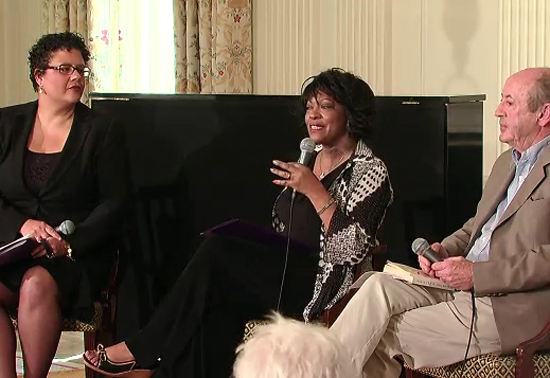
Elizabeth Alexander, Rita Dove, Billy Collins (left to right) the White House Poetry Workshop
The diverse panel gave the Poetry Workshop a beautiful edge in a format which invited two poets at a time onto the stage; Rita Dove and Billy Collins began. Rita Dove asked in what way poetry moves us, how important is it to make poetry our own and offered that she uses draft work to get the words just right. She claimed inspiration from the renowned children’s book titled, Harold And The Purple Crayon, saying you have to follow your own purple path. Billie Collins, pointed out that the mission of ‘finding your own voice’ can be a bit daunting, overwhelming. He went on to say that sometimes deep introspection or finding a mystifying authenticity doesn’t work. He approached writing by loosening this kind of pressure, proposing we read as much poetry as we can get our hands on. Suggestions such as finding the poems of which we are jealous and creating our own versions, a willingness to write some bad poetry until it grows into something we like, also works. Rita Dove described playing with poetry, having fun with language to the point where we’re more interested in the poetry than in our own persona.
One of the young poets asked “at what point did you stop searching for your voice?” Billie Collins explained that the way to originality is through imitation, implying that through imitation we move into our own voice. Rita Dove described teaching through play with language in a game she offers her students in which a series of wild cards contain instructions, such as at the first sign of the moon, sit and write a haiku, questioning the need for heavy handed teaching rather than lending our process of development itself a more poetic contour.
Kenneth Goldsmith and Alison Knowles followed as the next poets to face the audience. Being familiar with the work of both artists I knew this would be the experimental portion of the panel.

Kenneth Goldsmith, Alison Knowles (left to right) the White House Poetry Workshop
Kenneth Goldsmith encouraged us to literally re-type a chosen work verbatim to understand it more fully, to leverage word processing and the information superhighway. He suggested we take poetic license and re-work existing material into new material, claiming there is no reason for writer’s block when we can go to the computer and process something new out of an ocean of pre-existing texts.
Alison Knowles offered the idea that we share whatever we write with another person, whether the work is good or bad. She described starting out as a mediocre painter because she wasn’t getting the meaningful feedback she needed from her friends, feedback which later guided her to become a different kind of artist and poet and she pointed out that including people and sharing the art is important in creating community. Lifting a signature handmade flax drum filled with beans, she refers to as a “bean turner,” the sound of rain echoed her words. In her world, poetry crosses into objects, sound or performance. By the end of the workshop Aimee Mann added that as a songwriter she enjoyed working with language plus music and understanding how powerful they become as they intertwine.
The Poetry Workshop at the White House left many of us pondering the diverse methods and experiences each poet brought to the description of their ways of art-making, yet the finest poetry came from Mrs. Obama who summed up the essence of how these diverse approaches benefit our communities when she asked a special question, regarding what poetry is really all about, to the young poets sharing the day at the White House.
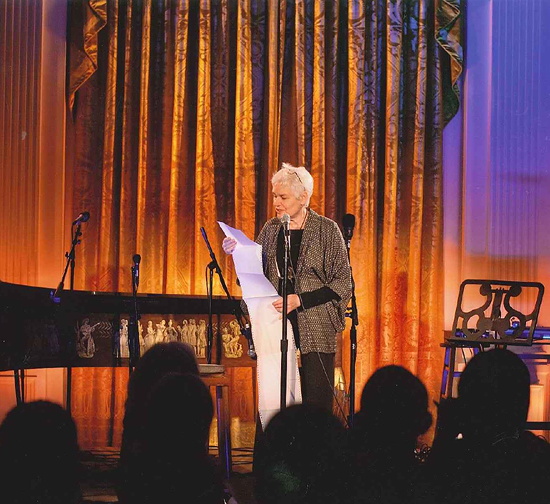
Alison Knowles reads The House Of Dust at the White House Evening Of Poetry
“You got this experience to be here, right? So you are fortunate. You are blessed. So the question after this is what are you going to do to pass it on? What are you going to do to give this gift back? Because, not everybody could fit in this room.” (Mrs. Obama)

Alison Knowles reading The House Of Dust streaming live on the White House
internet channel reaches young people where they live (whitehouse.gov/live)
Reinvesting in Arts Education – Winning America’s Future Through Creative Schools: The President’s Committee on the Arts and the Humanities (PCAH) announces the release of its landmark report Reinvesting in Arts Education: Winning America’s Future Through Creative Schools. The culmination of 18 months of research, meetings with stakeholders, and site visits all over the country, this report represents an in-depth review of the current condition of arts education, including an update of the current research base about arts education outcomes, and an analysis of the challenges and opportunities in the field that have emerged over the past decade. It also includes a set of recommendations to federal, state and local policymakers. A summary of the report is here.
Tiesha Hines: born in Washington, DC. She is a senior at Ballou Senior High School where she is the president of the poetry club and a member of a variety of extra curricular activities. Tiesha started writing poetry at age 7 for her friends, family and church members of Matthews Memorial Baptist Church. Her favorite style of writing is m.c. style. She was inspired to write by her sister and a few famous poets. Tiesha plans to go to Fortis College and Trinity University to study criminal justice and will continue to do poetry on the side.
Elizabeth Alexander: is an accomplished poet, essayist, and playwright. She began teaching English at the University of Chicago in 1991 and has risen to chair the African American Studies department at Yale University, where she currently works. Her writing has been published in The Paris Review, American Poetry Review, The Village Voice, and The Washington Post and her play, Diva Studies, was performed at the Yale School of Drama and garnered a National Endowment for the Arts creative writing fellowship. Alexander has released several volumes of poetry, most notably American Sublime in 2005 which was one of the three finalists for the Pulitzer Prize that year. Additionally, she became the fourth poet ever to speak at a Presidential Inauguration in 2009 when she recited her poem “Praise Song for the Day,” written for the occasion.
Billy Collins: author of nine collection of poetry, including most recently Horoscopes for the Dead. He is also the editor of three anthologies: Poetry 180: A Turning Back Poetry, 180 More: Extraordinary Poems for Everyday, and Bright Wings: An Illustrated Anthology of Bird Poems. He is a Distnguished Professor at Lehman College, City University of New York, and a Distinguished Fellow of the Winter Park Institute at Rollings College. He served as New York State Poet (2004-2005) and United States Poet Laureat (2001-2003).
Rita Dove: Commonwealth Professor of English at the University of Virginia and former U.S. Poet Laureate and Consultant in Poetry at the Library of Congress, is the author of nine collections of poetry, including Thomas and Beulah, winner of the 1987 Pulitzer Prize, and, most recently, Sonata Mulattica. Her publications include short stories, a novel, and the drama The Darker Face of the Earth, which was produced at the Kennedy Center and London’s Royal National Theatre. Ms. Dove has received numerous honors, among them the NAACP Great American Artist Award, The Heinz Award, the National Humanities Medal, the Common Wealth Award of Distinguished Service, and the Fulbright Lifetime Achievement Medal. In 1993 she was featured poet at President Clinton’s first state dinner. A Chubb Fellow at Yale University and the recipient of 22 honorary doctorates, Dove is also chancellor of the Academy of American Poets and a former senator of Phi Beta Kappa.
Kenneth Goldsmith’s writing has been called “some of the most exhaustive and beautiful collage work yet produced in poetry” by Publishers Weekly. Goldsmith is the author of ten books of poetry, the founding editor of the online archive UbuWeb, and the editor of I’ll Be Your Mirror: The Selected Andy Warhol Interviews. A documentary on his work, Sucking on Words, premiered at the British Library in 2007. He teaches writing at The University of Pennsylvania and held the Anschutz Distinguished Fellow Professorship in American Studies at Princeton University 2010. His book of essays, Uncreative Writing, is forthcoming from Columbia University Press.
Alison Knowles: American visual artist known for her soundworks, installation, performances and publications, and as a founding member of Fluxus. In 1967, Knowles produced what is considered to be the first computerized poem The House of Dust in collaboration with composer James Tenney. In the 1960s, Knowles composed the Notations book of experimental composition with John Cage, and Coeurs Volants, a print with Marcel Duchamp. Her acclaimed exhibits and performances include two walk-in book installations “The Big Book” and “The Book of Bean.” In 2008, she performed three Event Scores at the Tate Modern in London, and in 2009 she exhibited and performed in The 3rd Mind” American Artists Contemplate Asia, 1860-1989 at the Guggenheim Museum. She was appointed guest professor at Documenta X in Kassel, Germany, and in 2009 was an artist-in-residence at the Radcliffe Institute for Advanced Study at Harvard University. An edition of The House Of Dust is due to publish this Fall.
Aimee Mann: In the 1980’s formed the post –new wave pop group ‘Til Tuesday, and went on to establish herself as a distinguished singer-songwriter. She has received multiple Grammy nominations, one Grammy award and released seven critically acclaimed solo albums, including the soundtrack for the film Magnolia, which garnered an Academy Award nomination for Best Song in 2000. She has gone on to record soundtracks for several other films and has released widely praised solo albums including Bachelor No. 2, Lost in Space, and One More Drifter in the Snow.
Michelle Obama: née Robinson, the wife of President Barack Obama, was born on January 17, 1964 in Chicago, Illinois. She is a lawyer and was a University of Chicago Hospital vice-president. She is the First Lady of the United States and Honorary Chair, the President’s Committee On The Arts And Humanities. The Student White House Poetry Workshop is a part of the initiative Reinvesting in Arts Education.
Melody Barnes is the Director of the White House Domestic Policy Council.
Joshua Selman serves as President of 501(c)3 Artist Organized Art, Inc.
Jessica Higgins: American artist, lives and works in New York and Massachusetts. Formative dance studies at Juilliard and Joffrey. Daughter of Fluxus Founders Dick Higgins and Alison Knowles. She has direct experiential knowledge of Fluxus, having early formation in that culture by way of the original members and by participation in historic Fluxus events. She is a regular correspondent for Artist Organized Art and the Creative Director of ‘Switch’ a local access television series of performance and intermedia out of Western Massachusetts. Her works and performances have exhibited in numerous countries.
Mrs. Michelle Obama for the President’s
Elizabeth Alexander, Rita Dove, Billy Collins (left to right) the White House Poetry Workshop
#permalink posted by Jessica Higgins: 5/12/11 09:00:57 AMMonday, December 27th, 2010
LUCIO POZZI IN FLORENCE:
Painting is the Matrix
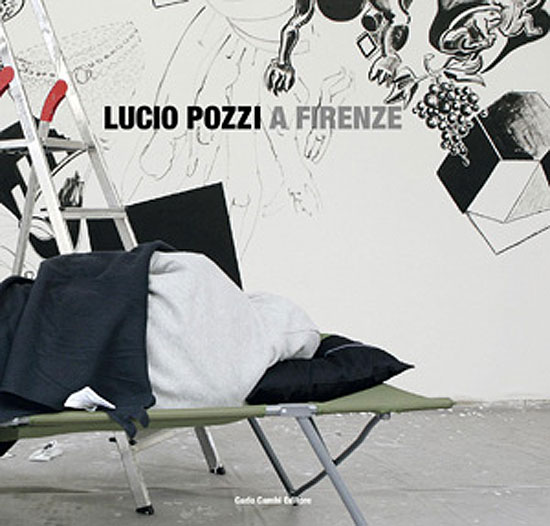
Lucio Pozzi in Florence, curated by Pier Luigi Tazzi. The book documents a series of events
dedicated to the artist which took place in Florence in October and November 2010.
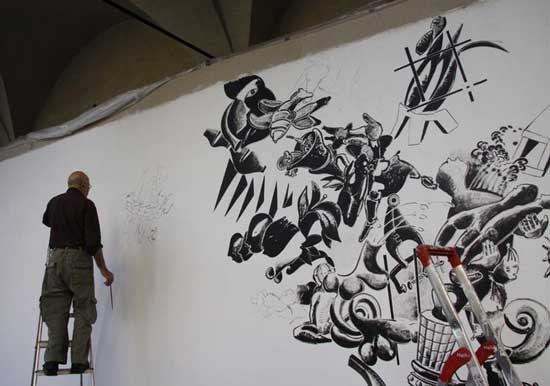
Lucio Pozzi, “I Like Painting and Painting Likes Me” Paintaction
October 4-21, 2010, Accademia di Belle Arti, Florence, Italy
Diversity is, after all, the very source of democracy. But factors of expediency like high-pressure salesmanship, organizational oversimplification and moneymaking as an end in itself have surely impaired the individual’s capacity to seek and understand the deeper potentialities of life.1
– Walter Gropius
An interview with Lucio Pozzi by Erika Knerr
The interview is a dialogue Lucio Pozzi and I began one month ago leading up to the publication of a new book about his work titled “Lucio Pozzi A Firenze.” This is a portion of the correspondence. The cover of the book shows Lucio napping on an army cot during his “paintaction.” Lucio is an artist full of surprises and one who defies definition. Like a seasoned meditation practitioner, Pozzi is quite adept at existing in the moment. His influences are far and wide coming from science, anthropology, psychology and poetry, dedicating his “lecturation” to Gregory Bateson, Wilhelm Reich, and Fernando Pessoa. His curriculum vitae, includes opera, video, performance, actions, non-actions, teaching, writing, curating, installation, sculpture, lectures and publishing. Most importantly though, Lucio Pozzi is a painter, and his most recent activities in Florence, Italy wrap themselves around painting. His attitude toward art keeps him successfully in the present, precisely, by his very consciously, staying clear of a particular classification, or grouping himself with any art manifesto. This has enabled him to take what he likes from history and the future, and to improvise and play with miscellaneous ingredients he calls “translation mechanisms.”
Two years ago I reconnected with Lucio Pozzi in the process of regenerating New Observations magazine, an artist run non-profit art journal, which published 128 issues from 1981-2001. Lucio was the founder and then ongoing contributor when Diane Karp came to reinvigorate and publish the magazine for 14 years until it went into hibernation in 2001. I art directed the magazine for a decade from 1991-2001. Before that I met Lucio as an MFA student at the School of Visual Arts and soon after began working at 142 Greene Street in Soho on his extensive “bio” which I recently found on his website at an astounding 77 pages. The third and most recent incarnation of New Observations is another story in progress.

An “8-hour-long inaction” in four venues in New York, Nicole Klagsbrun Gallery,
Marvelli Gallery, Esso Gallery and White Box
Performed April 24, 2008
Some of us experience an unbearable malaise. Precisely when art appears to be triumphant, when everywhere crowds are queuing up to visit exhibitions, we are dominated instead by the Competent Yawn of respectable clarity.2
– Lucio Pozzi
Erika Knerr: So as not to delay the project with too much forethought on my part, let’s just begin with where we are right now. I see there is a book coming out soon titled “Lucio Pozzi in Florence.” Is the book about your current exhibition “Endless” at the Gallery Frittelli Arte Contemporanea, that shows many of the diverse “families” of work you have cycled through? I am also quite interested in hearing about the recent “paintaction” (I Like Painting and Painting Likes Me). Was this painting performance a part of your Exhibition?
Lucio Pozzi: The two were separate events linked by time and city and organized by the same gallery Frittelli Arte Contemporanea. The documentation about both is included in one book to be published on December 15, 2010. The presentation of this book and of a DVD of my lecture “the Next 475 Years Of My Art And Life” in English is taking place at the Museo Marino Marini. On that occasion there is an informal hanging of large “Crowd Group” works on paper in that museum for a few days.
I feel it as a kind of miracle that so many of my ways of art are being presented concurrently and especially that the stress is on painting.

Lucio Pozzi, “I Like Painting and Painting Likes Me” Paintaction
October 4-21, 2010, Accademia di Belle Arti, Florence, Italy
EK: Yes, it has always been striking to me that all or most of your art activities have a dialogue with painting. The miracle you are feeling about this coming together creates a unique opportunity to see the whole artist, rather than one fragment or one part of the whole. Although, I know you see each piece, as it’s own “situation,” it feels important that all of these scores have been brought together. I am imagining many families coming together as a community. Have you encountered any surprises in observing this?
LP: In Florence many people appreciated seeing a whole group of my works from different families together. The curator, Pier Luigi Tazzi, was the person who could link the works by osmosis rather than by linear sense. He even put some Flower Paintings there, and viewers felt nonetheless that the show was one whole universe.
The conflict between parts and whole is an open question of this epoch, in which art’s purpose and criteria are not agreed upon.

Exhibition “Endless,” Lucio Pozzi at the gallery Frittelli Arte Contemporanea, Florence Italy
(09 October 2010 – 27 November 2010)

Exhibition Opening of “Endless,” Lucio Pozzi at the gallery Frittelli Arte Contemporanea
EK: Then calling these types of exhibitions Open Shows now, rather than Provocation Shows speaks to this still open question 30 years later. Your bio on the Frittelli site and your announcement talk about the early Provocation Shows. I really liked the story about the first of these shows in 1980 at John Weber in NY where the critical reaction was one of embarrassment and not knowing how to comment at seeing radically different works all shown together by the same artist. Now you call these Open Shows, like “Tuttipozzi” and currently “Endless.”
LP: The TUTTIPOZZI title was copied from the title of an article by Bill Zimmer in the SOHO Weekly News of 1980. He was playing a pun on the TUTTIFRUTTI name of a common ice cream.
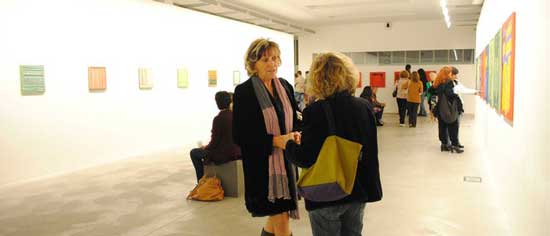
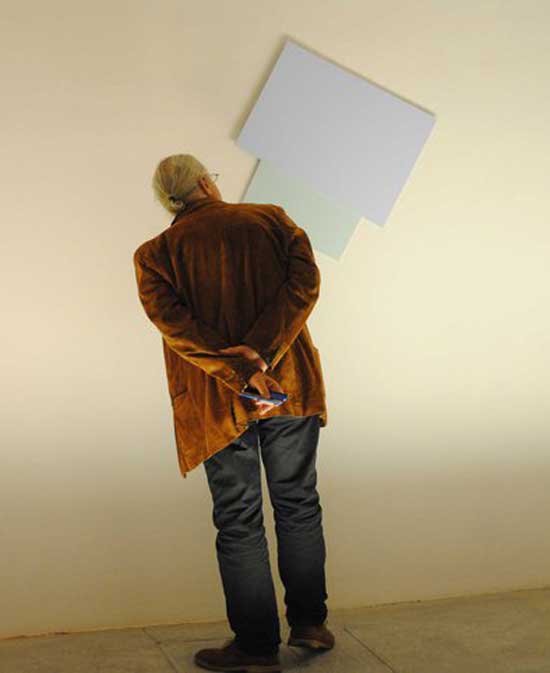
Exhibition Opening of “Endless,” Lucio Pozzi at the gallery Frittelli Arte Contemporanea
EK: It is interesting that you work in families.
LP: Pier Luigi Tazzi, , the curator of my Florence events, noted the similarity between my method and the connotation of Fractal Theory. You will read his comments in the upcoming book about me.
EK: The works in “Endless” are varied from one another, yet all painting. Your performance and installation work though is “Intermedia.”
LP: The definition and classification of my art is a business that will be better taken care of as time passes. For me so far some distinctions are merely instrumental for orientation’s sake. My underlying aim is to “GET OUT OF THE CENTURY” and it’s pedantic, suffocating exclusions that are still current in the art world. PAINTING IS THE MATRIX. It extends farther and farther until the end of time.
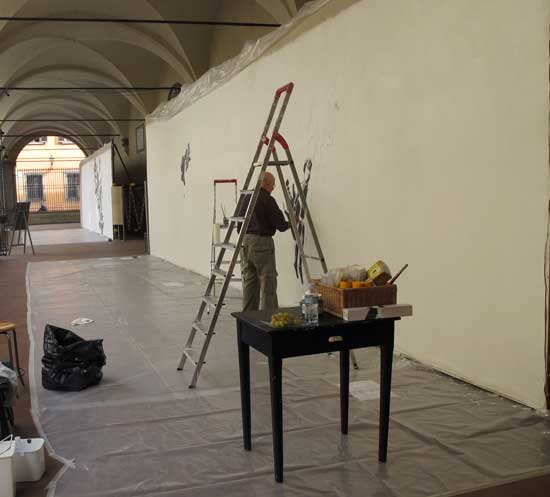
Lucio Pozzi, “I Like Painting and Painting Likes Me,” Paintaction
October 4-21, 2010, Accademia di Belle Arti, Florence, Italy
EK: I was provoking you by labeling your performance work as Intermedia, referencing this Fluxus concept. It is curious how one wants to define and classify things and the difficulty to allow something or someone to exist in itself outside of time and definition. Of course there are those that pride themselves and function quite well in a group. The collaborative aspect of performance art is something I have become involved in over the past few years. Many collaborative groups co-authoring works have emerged in the last decade. But this is different than an individual artist being sorted into categories for market consumption. There are many artists today moving freely between mediums, as you do, but your vehemence toward painting is epic and incisive at once.
LP: Painting: It’s worth considering that I and others stress painting as a matrix of our work. For me it is a passion and guideline and symbol of life itself, for others it is the only activity they care do devote their life to. But there is no need for it. I approach it as a readymade. It comes to me after having terminated it’s traditional functions. I even paint on canvas stretched on rectangular wooden stretcher, functionally an obsolete informational technique. This ineffectiveness enriches it.
No other technique or realm carries within it the conditions of thought and practice painting contains. Then, in order to understand and feel it even better not only from inside but also from outside, I started very early to explore painting also where it apparently is not. This exploratory manner of mine, which implies avoidance of packaged definition has led my work to be often excluded from limited-scope surveys such as ‘abstract art’, ‘representational art’, performance, site determined art. I find this delicious.

Materials and tools at the Paintaction.
EK: I had the great pleasure to see you perform your lecture “The Next 475 Years” in New York last November at SVA. I had seen it the first time in 1988, when I was an MFA student there. Where was the lecture done on the new DVD?
LP: In both English and Italian versions, at the Frittelli Gallery a couple of years ago.
EK: You have done this lecture for almost 30 years. Can you talk about how this began and how it has changed?
LP: It started at Hunter College and was long, people fell asleep. Having noted from, for instance, Andrei Voznesensky’s public enunciation of his poems that in a public speech the form of delivery is as communicative as it’s content, I proceeded to theatricalize my lecture. The basic concepts and slides are still the same but I every time re-invent what I talk about updating it to whatever context has evolved in my experience.
EK: There was an issue of New Observations Magazine published in 1983 with the same name.

New Observations, Issue #12, 1983
LP: That issue contained actually a short free-association story, which the Frittelli Gallery might re-publish soon. It had nothing to do with the Lecturaction, but perhaps was at the origin of the title.
EK: Did this precede the “Lecturaction”?
LP: It could have.
EK: Where did this title come from?
LP: The title refers to several layers of considerations about this juncture in art history and my own attitude in it. One of these is my feeling that what we call art implies a projection towards an impossible future. Lacking any agreed-upon purpose, art contributes a testimony of the crucial importance of un-necessary speculations exploring the “deeper potentialities of life” (Walter Gropius). I tried, but can’t recollect how I settled on the numeral 475. It might just have been a sign of my extreme yearning to transcend the cage of time.

Lucio Pozzi, “I Like Painting and Painting Likes Me,” Paintaction
October 4-21, 2010, Accademia di Belle Arti, Florence, Italy
Rather than lamenting the end of civilization and projecting my attention towards a utopian future or a nostalgic past, my response to the fragmentation and discontinuity of my culture is to be in the present moment as much as I can.
The invention of art, in my bias, does not presuppose explanations, while, on the other hand, interpretations of it dialogue with the art as creative acts in their own right. I hope that interpretations of art are always to a degree besides the point, i.e. so intensely within themselves that they correspond with the art more than they respond to it.
I see my art as a weaving web of interconnected but independent specific universes. The web’s end is unknown.3
– Lucio Pozzi
Lucio Pozzi was born in 1935 in Milan, Italy. After living a few years in Rome, where he studied architecture, he came to the United States in 1962, as a guest of the Harvard International Summer Seminar. He then settled in New York and took US citizenship. He now shares his time between his Hudson (NY) and Valeggio (Verona) studios.
In 1978 the Museum of Modern Art, New York, exhibited his early videotapes in one of the first single-artist exhibitions of the Projects:Video series. He occasionally writes and has taught at the Cooper Union, Yale Graduate Sculpture Program, Princeton University and the Maryland Institute of Art. He currently is an instructor at the MFA and BFA programs of the School of Visual Arts, in New York.
His teaching is another way for him to question and probe the fabric of modern art making, in a subtle, individual, case by case dialogue, a capillary manner of guerrilla infiltration instead of shouting sensational slogans.
His art is represented in the collections of The New York Public Library; The Detroit Institute of Arts, Detroit; The Museum of Modern Art, New York; The Whitney Museum of American Art, New York; The Museum of Contemporary Art, Chicago; The Art Gallery of Ontario, Toronto; The Fogg Museum, Cambridge Mass.; Centro per l’Arte Contemporanea Luigi Pecci, Prato, Italy; Giuseppe Panza Di Biumo, Lugano, Switzerland; Herbert and Dorothy Vogel, New York; PS1 Contemporary Art Center, New York; Museum of New Art, Detroit, MI.; Zimmerli Art Museum, New Brunswick, NJ.; Kalamazoo Institute of Arts, MI; Hartford Atheneum, Hartford, CT; Marzona sculpture park, Italy; Portofino Sculpture Museum, Italy; Museo de Bellas Artes, Buenos Aires, University of California Art Museum (Berkeley), Miami Art Museum, Miami, Florida; Collezione Maramotti, Reggio Emilia, Italy; Fondazione Cariverona, Verona, Italy, and in various private and corporate collections.
Pozzi was honored with a National Endowment for the Arts Fellowship in 1983. He received a Master Honoris Causa from the Accademia di Verona, Italy, in 2010.
Retrospectives of his art were held at Kunsthalle Bielefeld (1982) and Badischer Kunstverein, Karlsruhe (1983), Germany, and at the Museum of New Art (2001), Detroit, MI, Kalamazoo Institute of Art, Michigan (2002); Works on Paper, Mus. Contemp. Art, Genova Italy, 2005. His work has been presented at Documenta 6 (1977) and at the Venice Biennale (American Pavilion) in 1980.
Lucio Pozzi is the Founder of New Observations Magazine and still serves on its Board.
Pier Luigi Tazzi (Capalle, Italy / Bangkok, Thailand) is an independent art critic and curator based in both Florence and Bangkok. Formerly a lecturer at the University of Florence, he has contributed to Artforum, Kunst & Museumjournaal, and Wolkenkratzer. Tazzi was a curator at the 43rd Venice Biennale (1988) and was associate director of documenta 9 (1992). Significant exhibitions include Wounds: Between Democracy and Redemption in Contemporary Art (1998), Moderna Museet, Stockholm; Happiness: A Survival Guide for Art and Life (2003-2004), Mori Art Museum, Tokyo, (both co-curated with David Elliott); and the 1st Aichi Triennale (2010).
Gallery Frittelli Arte Contemporanea is a contemporary art gallery in Florence, Italy. Carlo and Simone Frittelli opened new spaces in via Val di Marina 15 in Florence with the help of architect, Adolfo Natalini, thus continuing the experience that began in 1990 in the Centro d’arte Spaziotempo near S. Croce, in the heart of the city, transferring the new gallery to the North, near the airport.
Erika Knerr is a painter working in Western Massachusetts and New York.
1. Gropius , Walter. Scope of Total Architecture, New York: Collier Books (1962).
2. New Observations magazine, Issue #48, May, 1987. DAIMON, edited by Lucio Pozzi. Lucio Pozzi, Muddening Clarity, 1985.
3. New Observations magazine, Issue #113, 1996. Ripple Effects: Painting and Language, guest edited by Susan Bee and Mira Schor. Lucio Pozzi, “Word Works,”.
#permalink posted by Erika Knerr: 12/27/10 12:10:56 AMFriday, December 10th, 2010
Humanism of the automated other;
or reading Baruch Gottlieb’s i-Mine1
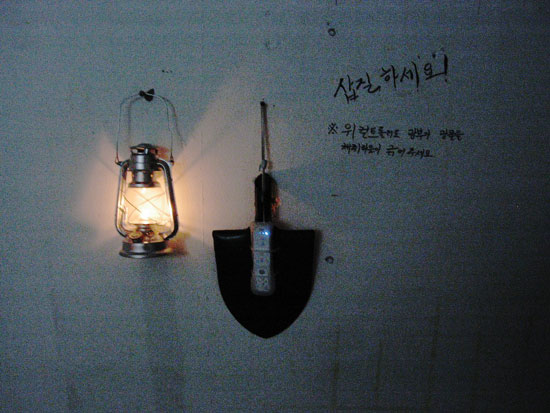
Wii Controller To Activate
Jeremy Fernando
This ‘beyond’ from which the face comes and that sets consciousness in its rectitude, is it not in turn an unveiled understood idea?
(Emmanuel Levinas, Humanism of the Other: 38)
Stepping into the Second Order (http://www.secondorder.kr/) exhibition at Space Hamilton, Seoul (http://spacehamilton.com/), one is struck by the fact that one is not in a gallery-it is, as its name invokes, a space. Here, one can all too easily hear notions of the openness needed for though, action even; extending perhaps to calls for interventions. And there is nothing at Space Hamilton itself to deny that gesture-walking in during a freezing Wednesday evening, 8 December, 2010, one is hit with a final frontier of sorts.
This physical discomfort though pales in comparison with the encounter that Baruch Gottlieb opens with his work i-Mine: it is a drop into a cold, yet invigorating, stream of Kierkegaardian absurdity.2 In adopting, naming, and being, an avatar whose sole role is to mine for minerals fast enough to keep overall prices down, whilst slow enough for them to maintain a minimal level, one also has to contend with a soldier that is awaiting any opportunity to steal from you, and who inevitable shoots you-one cannot win at this game; one can only stay alive, awhile longer. This is a game-there are exact rules to staying alive-where death confronts you, is staring at you, is always already with you; perhaps only not just yet.

Audience Playing i-Mines On
A question that Gottlieb faced throughout the opening, and later at a dialogue session on Saturday, 11 December, was whether a game, at an exhibition at that, was an appropriate venue for a meditation on the death, and life-hours, of people that are inscribed in all technology. Perhaps here, if we listen carefully, we can hear Lenin’s eternal question echoing in the background: that of “what is to be done?” After all, a question of relevance is almost always also a question of ‘what can we do about it; how can we change the situation’. And like any self respecting artist, Gottlieb is holding up a mirror to society, and thus in a way is also bringing down the question on himself. To compound matters, by using technology to open his quest, Gottlieb exposes himself, opens his self to the scrutiny of those very same questions. However, what we must never forget is the notion of the quest in question-it is constantly moving, searching, probing, opening. In this way, perhaps what is to be done is precisely what is done-there are no prescriptions here. All we can do is attempt to hear; listen.
By exposing himself, his self, Gottlieb and his quest will always be haunted by this question. This is especially true as he positions this piece as part of a larger work which intends, attempts, to trace, and document, the echoes of human lives in all devices. And since a project of this magnitude can only be approached through computers, computing-and ultimately a calculating formula-the question of context, and whether natural lives and deaths can be thought through an artificial medium, resounds loudly.
But in this quest, we must not make the mistake of paying too much attention to the question; we must not allow the question to take over the quest. For, in every question, there is always already an echo of the meta hodos-the path over which we attempt to travel. It is not a random searching though: there is a method, a way, a strategy, even though the ending is never known, perhaps until, or even after, it arrives. Hence, even as we quest, even in an attempt to respond to the question, we must never allow the question to determine the end-a teleology-of the quest. Thus, in some way, this question, like all questions, completely misses the point.
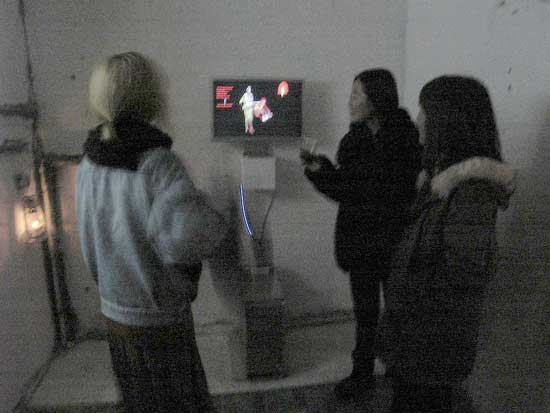
Playing the i-Mines Game
One can only attempt to respond to the other, to the other in her full otherness, whilst maintaining a gap, a space between one’s self and her. Otherwise, all one is doing is subsuming her under one’s self, consuming her-otherwise one is calling her i-mine. In order that the other remains fully other, one has to gaze at her, look even, but never claim to have seen her-her face must always already be veiled from us. The other must remain distant, foreign, unfamiliar-artificial.
And what better way to foreground this artificiality than at an exhibition-made even more disconcerting by the fact that the exploitation of human lives for mobile phones is played out on a mobile phone, by everyone who has one sitting snugly in their pocket, or bag.
Faced with that level of absurdity, it is all too tempting to echo Lear and tear out one’s hair in the storm. But that would be too easy, too convenient-a disavowal through excess, a momentarily release through madness.
What Gottlieb’s i-Mine forces us to confront is far worse.
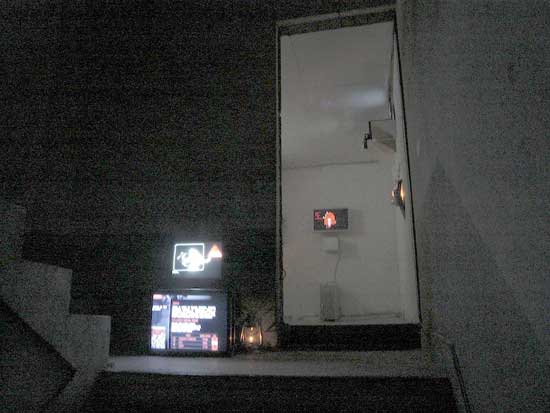
Score Board For i-Mines Game
Violence, death, blood, is a very part of our existence, is what our lives-and the way we live-depend on. We can no longer complain about the barbaric sacrifices of the Aztecs so that the sun may rise again-at least they knew her name, her face, her story. All we are doing is offering deaths blindly, indiscriminately, randomly. This is not a sacrifice-there is no longer a God.
This is a shoah.
We would like to think that we have come far. The shiny objects that we use in our daily lives help with this illusion. Gottlieb shows us that all we are doing is hiding behind a screen.
Can you tell a green field from a cold steel rail?
A smile from a veil?
Do you think you can tell?
(Pink Floyd: Wish you were here)
*****
Jeremy Fernando is the Jean Baudrillard Fellow at the European Graduate School. He works in the intersections of literature, philosophy, and the media; and is the author of Reflections on (T)error, Reading Blindly, and The Suicide Bomber; and her gift of death. Exploring other media has brought him to film, music, and art; and his work has been shown in Seoul, Vienna, Singapore, and Hong Kong. He is the editor of thematic magazine One Imperative; and is also a Research Fellow at the Centre for Liberal Arts & Social Sciences, Nanyang Technological University.
1 http://i-mine.org, the i-Mine apps for Android and iPhone, videos and related presentation materials were created by Baruch Gottlieb, Horacio González Diéguez and Cocomoya
2 One would expect the buzz from being awarded Design Capital of the World, 2010, to set Seoul’s art scene alight. Instead, one is confronted with a certain coldness, detachment, aloofness. But if we take into consideration the fact that what is foregrounded is creative production, then even as much as the claim is for diversity, culture, and design, this is always already a teleological premise; one directed towards performativity, productivity, product. And this is precisely why Gottlieb’s work is startling. For, even though it takes place in, and through, the medium of a mobile phone, it calls the very medium itself into question: a question that the quest for industrial design would like to leave veiled.
#permalink posted by Artist Organized Art: 12/10/10 04:26:51 PMTuesday, November 30th, 2010
James Bickford, Daphne Board,
Stan Geddes and Rachel Lawrence
Bring Your Own Restaurant (BYOR)
Holyoke, Massachusetts, a.k.a. “Paper City”

Holyoke Massachusetts, Downtown Paper City, Date and Orgin of Photo Unknown
By Denis Luzuriaga
Photos: Peter Palombella
On October 27, 2010, Bickford’s, a quick-lunch restaurant chain launched for the Automat market in 1921, closed the last remaining Connecticut store and the last remaining Western Massachusetts store with no notice to the staff and management. The closings came just before the dinner hour and left 40 employees suddenly terminated.
“My favorite thing that I brought was one of those one burner turkey fryer things… in it I steamed 5 dozen ears of corn on the side of the road and served with various herb infused butters, sea salt and cracked pepper. My pesto has been called “crack noodles” (by someone who actually never had pesto before), spring rolls, sushi… and when it is close to Sun Ra’s birthday I celebrate Arrival Day with a pot of moon stew at the nearest BYOR event.” – James Bickford (no relation)
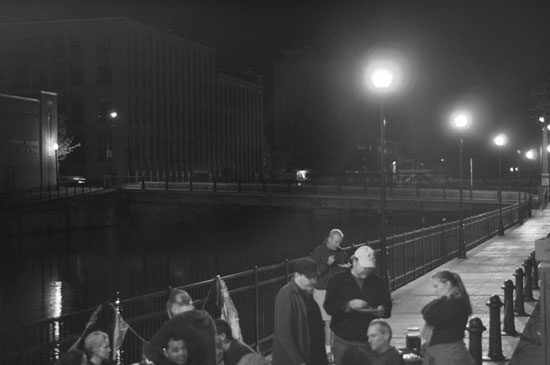
The tenth Bring Your Own Restaurant of 2010 at the Canal Walk, 1st level canal. 9/10/10
A brief history of Holyoke
Holyoke, Massachusetts had few inhabitants until the construction of its dam, the 1849 Holyoke Canal System and, at one point, over 25 water-powered paper mills. The American Pad & Paper Company was formed in Holyoke and is one of the largest suppliers of office products in the world. The street plan fosters high-rise buildings while the surrounding canals easily adapt to recreation and relaxation. Yet, through years of neglect, Holyoke has become among the poorest Massachusetts cities. Fifty percent of its school children live in poverty. According to a 2003 FBI Report its crime rate was significantly above the national average. Most of the year’s 2,822 crimes were property thefts. While on February 9, 1895, William G. Morgan invented the renowned sport termed “Volleyball” at the Holyoke YMCA. That YMCA building, as well as many of Holyoke’s ornate mill buildings and facades, has since disappeared due to urban decay, arson and rampant demolition.
More recently, in 2009, after visiting a few frontier art openings by the canals of post industrial Holyoke, four friends decided to take themselves out for a group meal. With establishments in the city officially extinct, James Bickford, Daphne Board, Stan Geddes and Rachel Lawrence resolved that the only way to find suitable public accommodations, in Downtown Holyoke, was to “bring their own restaurant.”
When an individual, a couple, a group of friends decide to dine together, the specifics very much depend on their coordinates, on the planetary nature of the site. Sharing a meal signifies a ceremony of sorts. Even in conditions of duress, urban decay, arson and rampant demolition, the communion of nourishment is a sacred one.
Bring Your Own Restaurant (BYOR) is described by it’s founding members as “A roaming plein-air potluck on the streets and canals of Holyoke.”
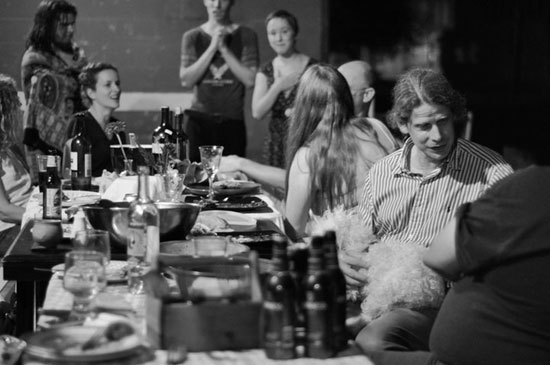
The first Bring Your Own Restaurant of 2010 during the Spring Open Studios
To quote Daphne Board, “BYOR is a bit of a ritual, and I love that as much as the element of surprise at each different place and with different people. Ritual with the element of surprise.”
Bring Your Own Restaurant, one asks. The answer – in Holyoke, Massachusetts – is “YES.” Why would city residents want to show up in a random, urban setting, carting all the trappings of a restaurant, tables, chairs, cloth napkins, real silverware and plates, flowers, candles, and excellent food? After all, by the plush safe agencies of 1960’s Madison Avenue, about the benefit of the Horn & Hardart Automat, it was famously said: “You can’t eat atmosphere.” Or can you? The dearth of “traditional” restaurants may be one reason, the unending quest for community another.
Daphne Board: BYOR is definitely a protest…I like James’ early description of BYOR as a protest against fear. It is a protest against the past abandonment of our downtown. Perhaps a playful or non-violent protest, art, a happening. Also a community gathering with almost no strings attached, It happens without the necessary logistics of house parties (no one is stuck doing *all* of the dishes!). In some ways it is very casual–we’ll be there, outside, in public, whether or not you are there. You can drop in for the whole event or just a while.
Rachel Lawrence: I guess the first event was sort of a performance piece and social statement, but I don’t know what it is anymore. Everyone who comes has a different idea on why and how they participate. It’s almost unbelievable that it goes so smoothly time after time. For me I guess it is art and spectacle as well as a way to get people out of isolation and routine and share a meal together the way so many other cultures do.
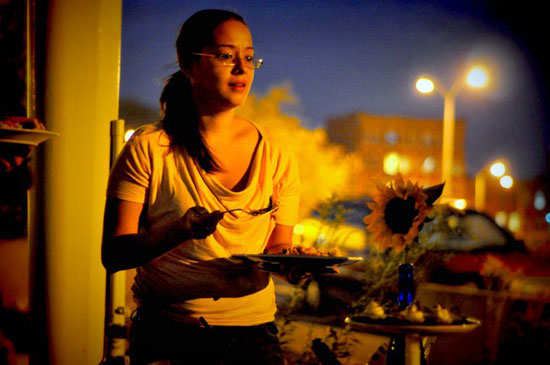
The eleventh BYOR of 2010, at the abandoned gas station near
Veterans Park, Dwight, and Chestnut. 9/24/10
James Bickford: To me it is an amalgam of epicurean experience, performance art, anarchism and community building. We have received a lot of attention lately and I have seen some criticisms, especially in regard to the NPR story. One person telling me: “wow… NPR makes a big deal out of this but all you created was the picnic” and “I love how you can do anything and people will call it art.” Well, yeah… you can do that. …and essentially we did not create anything new. It is a picnic, tailgate, pot luck, etc. but what does make it different, and what does make it a performance is what lies in the intent / purpose – we are intentionally moving the restaurant around every week and have been purposefully placing it in areas that people have come to consider “sketchy” or “dangerous”.
Denis Luzuriaga: Do you consider BYOR a social/food movement? Something more than Performance art/Happening? Something else entirely?
Daphne Board: BYOR is also a “bureaucracy-free zone”. Having just read some information on urban-place-making, the idea of a “BFZ” struck home. This was and is our intention: a simple formula, without much planning or permit-taking-outing. That sort of thing can be so tedious, and for what end goal? We just want to have a great time with unknown or known great people and great food.
James Bickford: We’ve also tried to make the setting, as much as possible, to include all the fineries of a nice restaurant – fine china, linens, and candles and occasionally costumes or we dress to impress (Stan and his pink tuxedo). If you are there as a participant in BYOR you are part of the performance. Part of our purpose is a response to the bad rap that Holyoke has earned over the years due to its failures in a declining economy, the loss of historic industry, rampant crime, numerous bad decisions on the part of city government and falling at the bottom of the list of near every possible statistic that is measured town by town and city by city in the state. One thing I think that I can speak for everyone involved is that we all want Holyoke to prosper and that we all are trying to create a positive image of community and good spirit in Holyoke with BYOR. …and there are many good things happening in Holyoke. I find it somewhat humorous that of all the things to report BYOR has gotten a lot more attention than I thought it would.
Rachel Lawrence: I think it would be great to have a website that describes the concept as we see it and hopefully it will inspire other communities to take the idea and make it their own. Of course things like this have been happening…sharing a meal is an ancient tradition…I think our emphasis on taking underutilized, abandoned and even “ugly” public spaces and giving them life is what makes BYOR different.
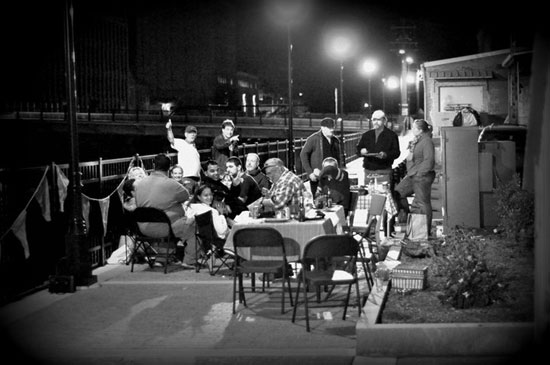
The tenth Bring Your Own Restaurant of 2010 at the Canal Walk, 1st level canal. 9/10/10
James Bickford: BYOR is also not all about Holyoke… I think that this kind of event could work in depressed economies with a similar story to Holyoke. With the attention that BYOR has received I hope to see it extend out and beyond. I mention “anarchism” in my initial response… I have always been a fan of the philosophical work of Hakim Bey, particularly his concepts of Immediatism and the Temporary Autonomous Zone (TAZ). The idea of absolute freedom in the moment and the ability for groups of people to create momentary spaces, usually gathering in public space and-or neglected / otherwise underutilized spaces while in doing so they elude the formal structures of society that normally create barriers… avoiding concepts like hierarchies, class, power, race, government. Everyone is welcome at BYOR, everyone is fed at BYOR and regardless of where we set up BYOR we still can see the streets and buildings around us but we are in our own little world for those few hours.
Daphne Board: I think as long as we explain what we are doing, the method should be easy enough to replicate wherever. It is not a difficult or particularly original concept, except in our downtown
Why eat in public when you could be in your own backyard? We’ve gotten that comment online mostly–people who see us and interact face-to-face have incredibly positive things to say. I can’t think of one negative experience actually at BYOR. But–the online world is like that. People feel free to slam each other in ways they would never think of when confronted in the “real” world.
I hope we can be in Holyoke for a long time, but one of our goals is to attract more restaurants to downtown. So it is a conundrum…what we are doing here right now is very special, but my hope is that we will become irrelevant. That our downtown will become vibrant at more hours of the day, not just during the 9-5 workday. Maybe we will have to move our events out to the mall, when it dies….
James Bickford: I always found TAZ (Temporary Autonomous Zone) to be a form of civil disobedience that should be practiced more often. It is a lot more inviting… rather than people seeing protests or anger they are witness to something they might actually want to participate in. People will walk an extra few blocks to check out what is happening… then they might join us. Lastly… it is great food. I am a foodie and a home-cooking kind of person, rarely eating out… BYOR is the best restaurant around. I do hope that things change in Holyoke and that we see small business and nice restaurant venues, theaters and galleries drawing people to our city – but this will be the death of BYOR. Maybe they can leave us just a few vacant lots?
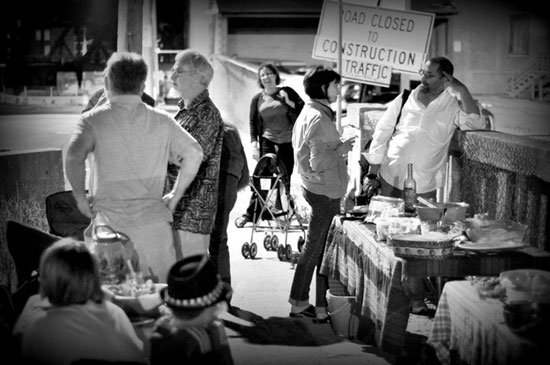
The ninth Bring Your Own Restaurant of 2010 on the Lyman St bridge
over the 1st level canal. 8/27/10
Rachel Lawrence: I think I need to learn how to say, “Would you like a cupcake?” in Spanish. I always bring vegan cupcakes….and my favorite thing to eat is Daphne’s bread or homegrown fruits and vegetables.
Daphne Board: I love South Indian food and fresh bread. Sounds crazy, but I am hard-pressed to find a BYOR location I don’t fancy. We do often briefly scope them out beforehand to see if they have enough access for people to load tables in, etc. There are definitely locations that we have not BYORed yet that I have my eye on. There are some prime canal-views that we have not taken advantage of, and someone suggested we BYOR over the Connecticut River on the Holyoke-South Hadley line, That would be amazing–and hopefully we can do that in the Spring when the river is full force over the dam. This year we went to a couple of underused parks and those were great (kids ran around, ricocheted off of the grass, etc). The modern under-usage of public parks in Holyoke is a phenomenon that I hope dies quickly–I have some old photos of the Victorian era when the parks were just filled with people of all walks of life. That said, the urban close-to-the-street locations are great because then we encounter people passing by (in cars or on foot). That’s when we have some really great interactions–BYOR makes people smile and engage.
Rachel Lawrence: Gas station!
James Bickford: Pulaski Park, on the canal at Dwight and Race St (location of the many buildings now occupied by art studios), HGE’s (the utility company) Energy Park, Lyman St Bridge when it was closed to traffic, on the new Canal Walk and when it has rained we’ve held BYOR at the loading dock at Open Square and under the canopy of an abandoned gas station. I love the canal as a feature, but the gas station comes out on top as my favorite spot. It still has some lights on so we’ve stayed pretty late there and I’ve seen some great photography from those two events.
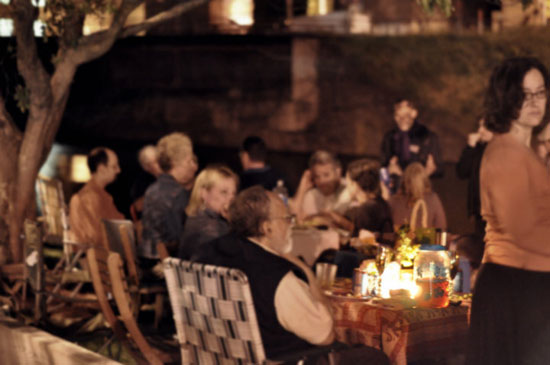
The second Bring Your Own Restaurant of 2010 at Water Power Park off North Canal Street
We are all in it together… we are trying to do something positive while apathy, racism and government cronyism has eroded the city for years.
Denis Luzuriaga: How do you envision BYOR in five to 10 years? How about the canal district of Holyoke; the art scene, and commerce in general?
Daphne Board: What do I think of commerce in general? I loathe commerce in general. A NYTimes headline declared that in order to save the world economy, we have to make the population of China “consumers.” How horrifying.
Rachel Lawrence: I have no vision for BYOR except for the fact that I hope it continues.
James Bickford: I think that in ten years to come we will have weathered the storm and we will find Holyoke to be a community that has succeeded. This will mean taking some risks. It will also have to be done without gentrification and/or the displacing of some of the people that have already taken the risk – like the existing art community.

The eleventh BYOR of 2010, at the abandoned gas station near
Veterans Park, Dwight, and Chestnut. 9/24/10
James Bickford: “Rather than a long and involved story about my degrees, awards, shifting career paths, military service, time in prison, feats of strength or works in permanent museum collections, I will instead use these words to describe myself: Anarchist, Activist, Culture Jammer, Anti-Artist, Agent of Chaos, Noise Maker, Mask Maker, Explorer, Biologist, Technologist, Foodie, Analog Luddite, Father, Friend, Neighbor, Thinker, Guinea Pig Herder, Psychonaut, Strategist”
Daphne Board is a shoemaker and loves living in Holyoke
Stan Geddes is one of the Founders of Bring Your Own Restaurant in Holyoke, MA where he lives and works
Rachel Lawrence: mother, artist, student, unemployed terrorist, head crumb maker at We Are All Beasts Super Secret Renegade Underground Second Floor Vegan Bakery and Guinea Pig Sanctuary and the primary alchemist at The Vegan Owl a late night bistro, political salon and cookzine publisher
Denis Luzuriaga: visual artist working in Western Massachusetts. He combines video, painting, and sound in what can be termed “sense-scapes.” His latest work “Temporis” is a two channel video and sculptural installation. Temporis is installed in a 150 year old mill building along the Connecticut River. Denis exhibits his work in galleries, exhibition spaces, and works with outsider artists performing irreverent versions of yester-year avant-garde such as Kurt Schwitters’ “Ursonata” electrified.
Peter Palombella: sometimes better known by his online handle VanDog, is a photographer and blogger in Holyoke covering local events from Politics to Arts and Culture
Bring Your Own Restaurant (BYOR): Do it yourself fine dining on the streets of Holyoke. A plein air potluck held every other Friday, 7pm start, rain or shine and from Spring until late Fall. All are welcome. If you would like to join us, bring a dish of something edible to share, your own plate, chair, utensils, etc. and we will enjoy the lovely view in downtown Holyoke with good company. Bringing your own table is recommended, but if you are solo there is always space at someone else’s table. We will have a couple of chairs on hand for those without access to cars. We would like this to be a trash-free event, so please do not bring disposable plates or other items that will end up in the landfill! Dress to impress or dress to de-stress. No reservations
Holyoke is a city in Hampden County, Massachusetts, United States, on the banks of the Connecticut River. It is part of the Springfield, Massachusetts Metropolitan Statistical Area. The city was named after Elizur Holyoke, who explored the area in 1660. One of the first planned industrial communities, Holyoke bears the nickname “Paper City”
Horn and Hardart initiated their first Automat restaurant in the USA in Philadelphia on June 12, 1902, borrowing the concept of automatic food service from a successful German establishment, Berlin’s Quisiana Automat. The first New York Automat opened in Times Square July 2, 1912. Later that week, another opened at Broadway and East 14th Street, near Union Square
Bickford’s: Samuel Longley Bickford (1885–1959) began his restaurant career in 1902, and in 1921, he established his quick-lunch Bickford’s restaurant chain. In 1921, the Bickford’s “lunchrooms,” as they were known, offered modestly priced fare and extended hours. Bickford’s architect was F. Russell Stuckert, who had been associated with Samuel Bickford since 1917. Stuckert’s father, J. Franklin Stuckert, had designed buildings for Horn & Hardart in the 1890s. Jack Kerouac sometimes wrote while sitting in Bickford’s, and he mentioned the restaurant in Lonesome Traveler. Other famed members of the Beat Generation could be found at night in the New York Bickford’s as noted by The New York Times: The best minds of Allen Ginsberg’s generation “sank all night in submarine light of Bickford’s,” he wrote in Howl. The Beat Generation muse, Herbert Huncke, practically inhabited the Bickford’s on West 42nd Street. Walker Evans photographed Bickford’s customers, and Andy Warhol rhapsodized about Bickford’s waitresses. Bickford’s made its way into the work of writers as diverse as Woody Allen and William Styron. Andy Warhol’s assistant, Gerard Malanga, was out getting a coffee-to-go at Bickford’s when Warhol was shot. The Mad cartoonist Wally Wood was 21 years old when he worked as a Bickford’s busboy shortly after his 1948 arrival in Manhattan
#permalink posted by Artist Organized Art: 11/30/10 03:08:09 PMFriday, November 12th, 2010
Rhys Chatham & Angie Eng
At The Kitchen, NYC
Guitar Trio At Flywheel, Easthampton MA

Angie Eng and Rhys Chatham: Echodes is an audio visual performance with noise guitar
by minimal composer Rhys Chatham and experimental video artist, Angie Eng
October 15 and 16, 2010 at The Kitchen, New York City
By Jessica Higgins
From her time in the early 1990’s as an organizer and driving creative voice behind The Poool, known for performances in New York City’s Knitting Factory, Roulette, Clocktower Gallery, Postmasters Gallery, Artists Space, internationally in Tokyo and culminating in performances at diverse venues such as CBGB’s, The Kitchen, Rensselaer Polytechnic Institute and Rutgers University, Angie Eng’s multi-media works have contained a curiosity of symbols, processes and intermixed layers flowing between conceptual and aesthetic combinations that have finally caught my full attention.
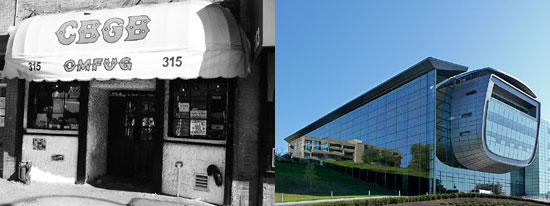
Left: CBGB’s, a club at 315 Bowery, NYC became a forum for The Ramones, Misfits,
Television, the Patti Smith Group, Mink DeVille, The Dead Boys, The Dictators,
The Fleshtones, The Voidoids, The Cramps, Blondie, The Shirts, and Talking Heads
Right: The Curtis R. Priem Experimental Media and Performing Arts Center (EMPAC)
is a multi-venue arts center at Rensselaer Polytechnic Institute in Troy, New York
After seeing her recent performance with Rhys Chatham at The Kitchen, I’ve been convinced of her original seriousness regarding her position as a feminist media artist in a manly media world leaning towards artists like Matthew Barney, Gary Hill, Bill Viola or Nam Jun Paik. Since the outset Angie has seen herself as a beneficiary of feminist media pioneers such as Joan Jonas, Steina Vasulka, Laurie Anderson, Charlotte Moorman and others, …take Mary Lucier. Also, though we only worked together more recently, Angie has been a personal friend who I met through strong links well over a decade ago.

Angie Eng peforming Echodes with Rhys Chatham
at The Kitchen, October 15, 2010, New York City
In 2007, I had the pleasure of working with Angie on her project at EyeBeam in Chelsea, a few blocks from The Kitchen. Eyebeam is an organization focusing on supporting research & development, production, education and public programs for artists, hackers, designers, engineers, graffiti artists, creative technologists and the general public. Because Angie also has a deep background in pedagogy, art therapy and social work, Eyebeam saw fit to Grant her a teaching program. Her project extended intervening public and private spaces to young people disinterested in school, giving them a chance to structure works for the streets. It also introduced the youth to pre-existing models of event based art, such as those by Fluxus Artists of the early 60’s and 70’s, as this is a specialty, this was mainly where I came in.
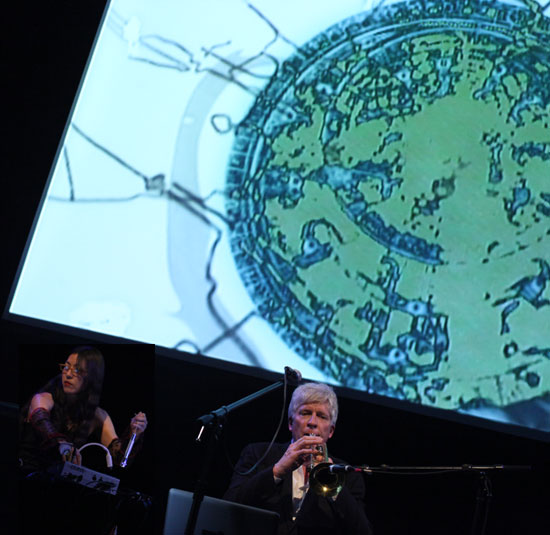
Rhys Chatham (trumpet) performs Echodes at The Kitchen, Oct. 15, 2010, New York City
In 2008, having survived Tompkins Square Riots, 9/11, the local plutocracy, mono-industry, mass migration to Williamsburg and other recent NYC annoyances, Angie bailed and became an ex-pat with a move to Paris, a city, which by comparison is devoted to the legacy of its communities, selling her furniture on the street and preparing herself with French classes. I was sorry to see this wonderful artist leave, but realized many artists were migrating during this time. I hoped I’d see more of Angie’s work down the line, or maybe in Europe one day, but for now it was our loss.
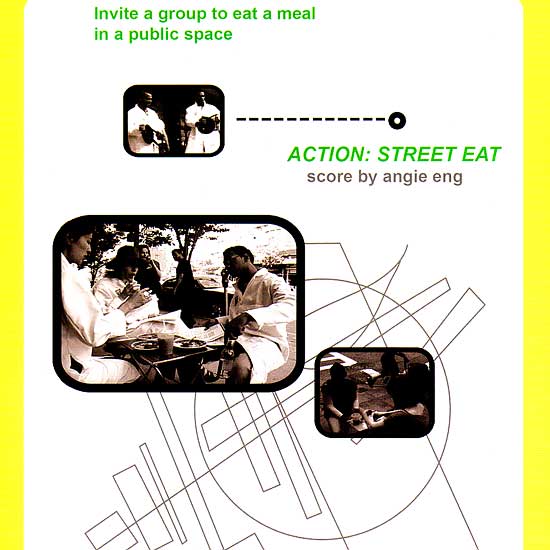
UAPD Street Eat, by Angie Eng collaborating with NYC artist, Jessica Higgins and students
Vietnamese artist, Rich Streitmatter-Tran led RMIT University students in Ho Chi Minh City
The groups conducted actions on themes related to private behavior in public space and
the filters prompted by mobile technologies and their impact on privacy in public urban sites
So it was to my pleasant surprise when I heard from Angie that she would return from Paris to New York’s’ premier performance space, The Kitchen, performing a major media work with none other than a founding curator of The Kitchen and an archetype of Downtown New York, Rhys Chatham. By leaving the city, miraculously Angie was now collaborating at its core.
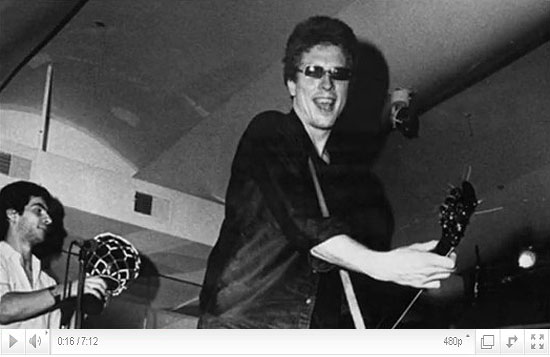
Photo: Vintage Rhys Chatam, Video: Guitar Trio Performed with Thurston Moore,
Lee Renaldo, David Daniell, Kim Gordon, Colin Langenus, Alan Licht, Robert Longo,
Byron Westbrook, Adam Wills, Electric Guitars – Ernst Brooks III, Electric Bass
Jonathan Kane, Drums, Recorded live Jan-27, 2007. Taken from “Guitar Trio Is My Life!”
Briefly, Rhys Chatham began his musical career as a piano tuner for La Monte Young and harpsichord tuner for Glenn Gould. He studied with Morton Subotnick and was a member of Young’s group, The Theater of Eternal Music, during the early 70’s. He also played with Tony Conrad in The Dream Syndicate. In 1971 Rhys became the first music director at The Kitchen. He produced concerts of Maryanne Amacher, Robert Ashley, Philip Glass, Meredith Monk, Pauline Oliveros, Steve Reich, Fred Frith, Robert Fripp, Arto Lindsay and John Lurie, and Thurston Moore of Sonic Youth later played in his ensemble. He also worked closely with Robert Longo and Joseph Nechvatal.
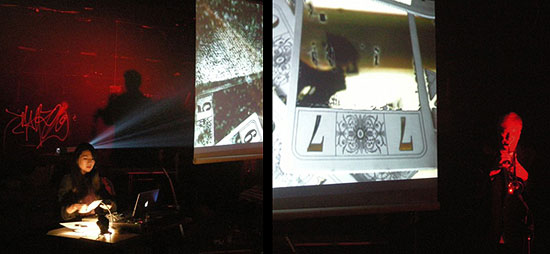
Angie Eng peforming Echodes with Rhys Chatham
at The Kitchen, October 15, 2010, New York City
Rhys Chatham’s serious music brought in influences by The Ramones in a wider sensibility known as No Wave. The sensibility emerged in 1978 along with one of his most famous works, Guitar Trio, performed around downtown Manhattan with an ensemble that included Glenn Branca and Nina Canal. Band of Susans began their careers in his ensembles and later performed a cover of “Guitar Trio.” In 1983 he began performing with the trumpet and his more recent works explore improvisatory amplified and circuit bending trumpet solos to which we were amply treated at The Kitchen.
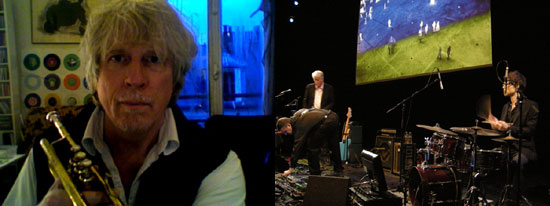
Rhys Chatham (trumpet) rehearsing Echodes at The Kitchen, October 15, 2010, New York City
The oddest coincidence took place a week before Angie’s appearance. I was out and about on a Saturday night in Easthampton Massachusetts with Erika Knerr who runs New Observations Magazine. We went over to Flywheel, “the” collective experimental performance venue of Western Mass. At Flywheel, Erika ran into an ex-neighbor from Greenpoint Brooklyn, none other than Thomas Lail of soundBarn & Albany Sonic Arts Collective, who had moved to Troy N.Y., home of the Rensselaer Polytechnic Institute and EMPAC. Tom said he had moved up there to teach experimental music and that he was in Easthampton to perform, of all works, Guitar Trio by Rhys Chatham. The ensemble was going on in about 20 minutes.
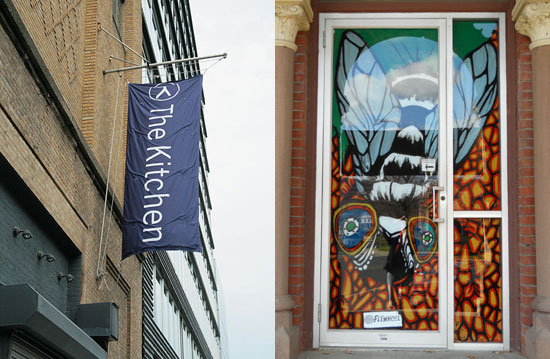
Left: The Kitchen Today (1985-Present) The Kitchen moved uptown to 512 West 19th Street
to begin the spring 1986 season and subsequetly purchased the space in 1987
Right: Flywheel, a collectively run, not-for-profit space, aims to build community and give
artists of all types the opportunity to craft, practice, and perform their work
located at historic Old Town Hall, Easthampton MA
I decided to stay to hear them and it turned out that Tom was also attending Rhys Chatham and Angie Eng at The Kitchen in NYC the next weekend. It was a very rich evening at Flywheel, not only was Guitar Trio a great performance of a vintage No Wave work by The G3 Ensemble with Thomas Lail, Tara Fracalossi, Patrick Weklar, Matt Ernst, Holland Hopson, Ray Hare, guitars; Eric Hardiman, bass and Matt Weston, drums, but it was complete with the original projections for music by Robert Longo. Opening for this, we were treated to a rare performance by Christoph Heemann of his impressive ear-movie-esque performance in drones, musique concrete and surrealist sound. I wondered what Angie would be bringing to The Kitchen, next week, with her own work in projected media for sound, music and a performance by Rhys Chatham himself.
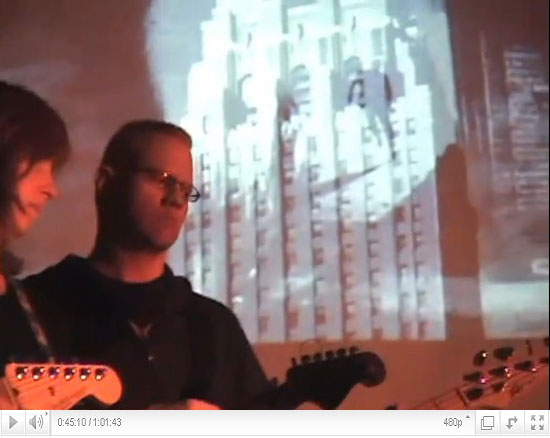
Albany Sonic Arts Collective (ASAC) + SoundBarn 10.9.10 FLYWHEEL EASTHAMPTON, MA
performing Guitar Trio, by Rhys Chatham, Musical Direction by Thomas Lail
Guitar Trio is a challenging piece using high amplitude to push the envelope of what one can endure sonically, of where hearing becomes tactile and of how we can literally be pierced by sound waves. It seemed very appropriate at Flywheel, as a venue in Massachusetts, because it has the energy of some of the most important raw early venues such as those I associated with Angie’s early years in The Poool and probably the early years for Rhys Chatham as well. Now at The Kitchen, which itself has gone from being a raw venue (it was literally the kitchen of the Mercer Arts Center when it started) to the polished upscale venue it is today, I am wondering about the evolution of No Wave and Downtown culture surviving and growing in Chelsea.

Angie Eng peforming Echodes with Rhys Chatham
at The Kitchen, October 15, 2010, New York City
Finally, later that week at The Kitchen in New York City, I attended the evening of music by Rhys Chatham with performed visuals by Angie Eng. Personally, I found that Angie’s work had gone far beyond anything I had seen her do before and certainly beyond her work with The Poool. I could also see more immersive and purposeful use of symbols and concept in the work, which achieved a stunning quality while remaining thought provoking, going all the way and beyond as picture for today’s music by Rhys Chatham. Would it have worked for Guitar Trio, probably Angie would have done something else and I would love to see that, but Robert Longo’s imagery is still very riveting and fits Guitar Trio like a tailored business suit. However, the new approach that Rhys Chatham is taking, involving more artists, syndicating his works and going beyond his own hit recipes, made for an evening with plenty of edge to it. For me it was a rare and surprising week filled with the music of an artist who has quietly been organizing conditions of art making for many years and making a permanent impression doing so. At the end of the concert I was quite stunned and found it difficult to prepare myself to go.
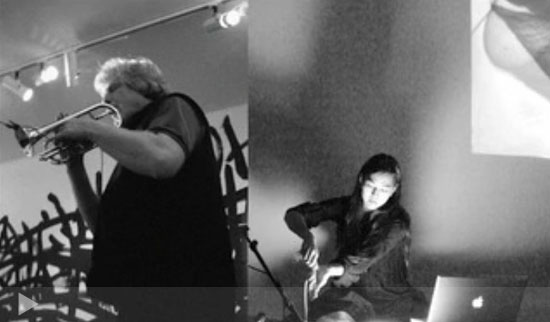
An early version of Echodes: Rhys Chatham and Angie Eng, Paris 2009
The Kitchen today has modernized and has a polished appeal associated with the times. It still offers a valuable slice of our postmodern culture. I remember the old Kitchen when it was in SoHo. In those days I was a youngster, lucky to be stomping around the place. The Fluxus concerts held there resembled a chaotic whirl, but I still see the black bowler hats of Olivetti and a floor covered in foam pillows up front for a crowded space.
Rhys Chatham began his musical career as a piano tuner for avant-garde pioneer La Monte Young as well as harpsichord tuner for Gustav Leonhard, Rosalyn Turek and Glenn Gould. He soon studied under electronic music pioneer Morton Subotnick and minimalist icon La Monte Young and was a member of Young’s group, The Theater of Eternal Music, during the early seventies; Chatham also played with Tony Conrad in an early version of Conrad’s group, The Dream Syndicate. In 1971, while still in his teens, Chatham became the first music director at the experimental art space The Kitchen in lower Manhattan. His early works, such as Two Gongs (1971) owed a significant debt to Young and other minimalists. His concert productions included experimenters Maryanne Amacher, Robert Ashley, Philip Glass, Meredith Monk, Pauline Oliveros, Steve Reich, and early alternative rockers such as Fred Frith, Robert Fripp, Arto Lindsay, and John Lurie. He has worked closely with visual artist/musician Robert Longo, particularly in the 1980s, and on an experimental opera called XS: The Opera Opus (1984-6) with the visual artist Joseph Nechvatal. Compositions from the late 1970s and early 1980s By 1977, Chatham’s music was heavily influenced by punk rock, having seen an early Ramones concert. He was particularly intrigued by and influential upon the group of artists music critics would label No Wave in 1978. That year, he began performing Guitar Trio around downtown Manhattan with an ensemble that included Glenn Branca, as well as Nina Canal of Ut. During this period, he wrote several works for large guitar ensembles, including Drastic Classicism, a collaboration with dancer Karole Armitage. Drastic Classicism was first released in 1982 on the compilation New Music from Antarctica, put together by Kit Fitzgerald, John Sanborn and Peter Laurence Gordon. It was also included on the 1987 album that also included his 1982 composition Die Donnergötter (German for “The Thundergods”). Members of the New York City noise rock band Band of Susans began their careers in Chatham’s ensembles; they later performed a cover of Chatham’s “Guitar Trio” on their 1991 album, The Word And The Flesh. (This parallels the way that members of fellow NYC noise rockers Sonic Youth began their careers in Branca’s ensembles; Thurston Moore of Sonic Youth did play with Chatham as well.) Chatham began playing trumpet in 1983, and his more recent works explore improvisatory trumpet solos; these are performed by Chatham himself, employing much of the same amplification and effects that he acquired with the guitar, over synthesized dance rhythms by the composer Martin Wheeler. His 1990s recordings in this style saw release on Ninja Tune Records as the compilation Neon.
Angie Eng is a media artist who works in video, installation and time-based performance. Eng was born in 1969 in San Francisco California. She was trained as a painter (UC Santa Barbara) in the post-classical tradition. She moved to New York City in 1993 and felt disconnected with the painting medium and soon discovered time based arts. During this time she became involved in the downtown electronic arts scene where she experimented with video sculptures, installation and with live video. (SoundLab, Fakeshop, Unity Gain,Pseudo Projects, PS 1 Clocktower Gallery) She collaborated on numerous video performance projects, including The Poool a live video performance group she co-founded and co-directed with Nancy Meli Walker and Benton Bainbridge in 1996-1999. She currently has a few video/music performance collaborations with Rhys Chatham (Echodes), Pascal Battus (Tremorrag) and a new women’s guitar video band (in the works!) Her work has been performed and exhibited at established venues such as, Whitney Museum at Philip Morris, Lincoln Center Video Festival, The Kitchen, New Museum of Contemporary Art, Renssalaer Polytechnic Institute, Eyebeam Art and Technology Center, Roulette Intermedium , Bronx Museum, Artists Space, Art in General and Experimental Intermedia. Her videos have been included in digital art festivals in local and international venues in Cuba, France, Greece, Japan, Holland, Germany, Former Yugoslavia and Canada. She has received grants and commissions: New Radio and Performing Arts, Harvestworks, Art In General, Lower Manhattan Cultural Council, New York State Council on the Arts, Jerome Foundation, Alternative Museum, and Experimental TV Center Finishing Funds. She has worked with composers, dancers, theatre, sound and video artists including: Ron Anderson, Rhys Chatham, Vincent Epplay, Yuko Fujiyama, Jon Giles, Andy Grayton, Jason Kao Hwang, Simon Hostettler, Jessica Higgins, Hoppy Kamiyama, Gabriel Latessa, Zach Layton, Okkyung Lee, Jarryd Lowder, Matthew Ostrowski, Jean Jacques Palix, Zeena Parkins, Ludovic Poulet, Liminal Projects, Kyoko Kitamura, David Linton, Thierry Madiot, Geoff Matters, Ikue Mori, Pauline Oliveros, Jane Scarpantoni, Peter Scherer, Jim Staley, Satoshi Takeshi, Yumiko Tanaka,Keiko Uenishi, Elisabeth Valletti, Vire Volte Theatre, Nancy Meli Walker and David Weinstein. She is also a European correspondent for AOA (Artist Organized Art) to support a critical dialogue between artists, art practice and dissemination via public events. She lives and works in New York and Paris.
Thomas Lail, Associate Professor of Art at Hudson Valley Community College is a visual artist and musician. He has exhibited drawings, collages and installations at: ArtCologne, Germany; Galeria Jan Koniarka, Trnava, Slovakia; now&then, London, U.K.; Smack Mellon Gallery, Brooklyn and numerous locations in the Capital District. He has been an artist in residence at NO.W.HERE studios in London, UK and has performed music with Lukomski/Majer/Lail and solo in New York City and the Capital District.
The Poool: Striving to form an all female video performance group, Nancy Meli Walker approached Angie Eng in the summer of 1995. Days later, a phone call from Benton Bainbridge who Meli Walker collaborated with in 77 Hz (a live video ensemble) prompted them to eliminate the sex criteria and start The Poool. Their first gig was the day after Benton escaped San Francisco and they “jammed” at Sound Lab, Chinatown. During the time The Poool was formerly known as The Pool with 2 o’s they performed at The Knitting Factory, Roulette, The Clocktower Gallery, Postmasters Gallery and Artists Space. As The Poool with 3 o’s, they went international to Tokyo, Japan as well as performing at local venues: The Kitchen, Rensselaer Polytechnic Institute and Rutgers University.
soundBarn is the experimental music duet of Thomas Lail and Patrick Weklar.
The soundBarn is a project of artist/musician Thomas Lail and artist/gallerist Tara Fracalossi and is located on what was once Heald Orchards in Valatie, New York.
Albany Sonic Arts Collective is a grassroots organization located in and around Albany, NY dedicated to building a thriving community of listeners and performers of music that exists outside of traditional boundaries with a special emphasis on forms that stress freedom and exploration of new ideas.
The Kitchen: Looking for a way to present their work to a public audience, Steina and Woody Vasulka rented the kitchen of the Mercer Arts Center (1971-1973,) in the former Broadway Central Hotel. The Vasulka’s, with help from Andy Mannik, opened The Kitchen as a presentation space for video artists on June 15, 1971. Later that year, the Vasulka’s added music to their programming and named Rhys Chatham the first music director. The Kitchen continued their eclectic programming at the Mercer Arts Center until the summer of 1973 when they began planning to move to 59 Wooster Street. In August 1973 the building that housed the Mercer Arts Center collapsed, making this decision final. The Kitchen moves to SoHo (1973-1986) The 1973-1974 season started in The Kitchen’s new location at the corner of Wooster and Broome streets in the former LoGiudice Gallery Building. During its time on 59 Wooster Street The Kitchen emerged as New York’s premiere avant-garde and experimental arts center. In addition to a performance space, a gallery and video viewing room were established at this location. The Kitchen Today (1985-Present) The Kitchen moved uptown to 512 West 19th Street to begin the spring 1986 season and subsequetly purchased the space in 1987.
Flywheel, a collectively run, not-for-profit space, aims to build community and give artists of all types the opportunity to craft, practice, and perform their work in an environment where creativity is valued over profit. Volunteer-run and governed by consensus, Flywheel believes that art and information should be equally accessible and affordable to all people. In the spring of 1998, Cindy Bow and Helen Harrison founded Valley Arts and Music Alliance (VAMA), a grassroots collective in which artists would help each other produce free, all- ages shows that reflected the their own creative visions rather than the values of the music industry establishment. VAMA attracted like-minded people, most of whom were already doing similar things in their own homes, church and dorm basements, record stores, VFW halls, and any other place they could find. Together the group produced over two-dozen shows through December of 1998, when a friend and supporter found a permanent space in Easthampton – a long-vacant cabinet store owned by a local doctor. As word of the space spread, more people joined, and Flywheel was born. Our doors opened in March of 1999. Since then, the unique expressions of countless artists continue to transform the space from day to day. In 2007, we decided to leave our home of 8 years at 2 Holyoke St. and relocate to Easthampton’s historic Old Town Hall. Over the years, some old friends have moved on while new ones have joined us, but the vision remains the same.
EMPAC: The Curtis R. Priem Experimental Media and Performing Arts Center (EMPAC) is a multi-venue arts center at Rensselaer Polytechnic Institute in Troy, New York, which opened on October 3, 2008. The director of EMPAC is Johannes Goebel. He was previously the director of the Institute for Music and Acoustics, which he founded at the Center for Art and Media Technology (ZKM) in Karlsruhe, Germany. EMPAC’s curators are Helene Lesterlin (Dance), Kathleen Forde (Visual Arts), and Micah Silver (Music and Sound Art). The building is named after Curtis Priem, co-founder of NVIDIA and graduate of the RPI Class of 1982, who donated $40 million to the Institute in 2004.
Jessica Higgins is an American artist, who lives and works in New York and Massachusetts. Formative dance studies at Juilliard and Joffrey. Daughter of Fluxus Founders Dick Higgins and Alison Knowles. She has direct experiential knowledge of Fluxus, having early formation in that culture by way of the original members and by participation in historic Fluxus events. B.A. from Suny, New York. Attended Art Students League and Parsons School of Design. “My work is primarily conceptual intermedia using action, dance, installation and visuals.”
#permalink posted by Jessica Higgins: 11/12/10 04:10:55 AM































































